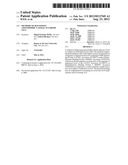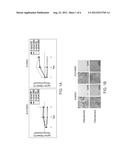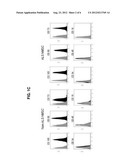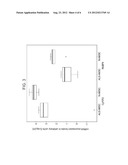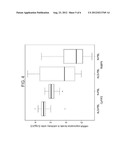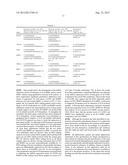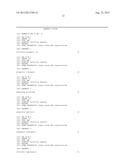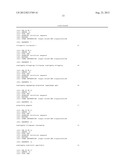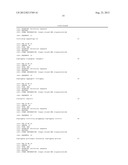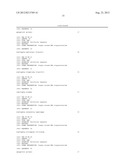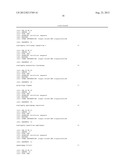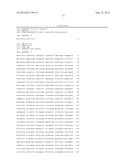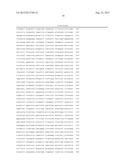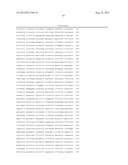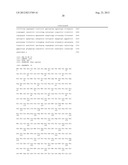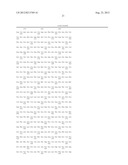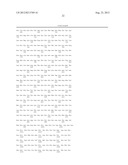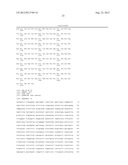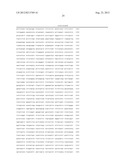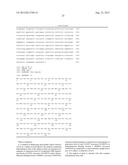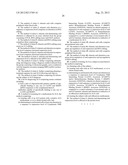Patent application title: METHODS OF DIAGNOSING AMYOTROPHIC LATERAL SCLEROSIS (ALS)
Inventors:
Miguel Enrique Weil (Tel-Aviv, IL)
Gideon Rechavi (Tel-Aviv, IL)
Assignees:
Ramot At Tel Aviv University Ltd.
IPC8 Class: AC12Q168FI
USPC Class:
4241301
Class name: Drug, bio-affecting and body treating compositions immunoglobulin, antiserum, antibody, or antibody fragment, except conjugate or complex of the same with nonimmunoglobulin material
Publication date: 2012-08-23
Patent application number: 20120213769
Abstract:
A method of diagnosing amyotrophic lateral sclerosis (ALS) in a subject
in need thereof is provided. The method comprising determining in cells
of the subject at least one alteration in a sequence or expression level
of Cytoplasmic FMR Interacting Protein (CyFIP2; Accession AF160973)
and/or Retinoblastoma Binding Protein 9 (RbBP9; Accession AF039564),
wherein an altered sequence or expression of the sequence or expression
level of the CyFIP2; Accession AF160973) or Retinoblastoma Binding
Protein 9 (RbBP9; Accession AF039564) as compared to a control reference
sample from a non-ALS subject, is indicative of ALS. The present
teachings may be implemented in screening for novel anti-ALS medicaments
and for treating ALS.Claims:
1. A method of diagnosing amyotrophic lateral sclerosis (ALS) in a
subject in need thereof, the method comprising determining in cells of
the subject at least one alteration in a sequence or expression level of
Cytoplasmic FMR Interacting Protein (CyFIP2; Accession AF160973) and/or
Retinoblastoma Binding Protein 9 (RbBP9; Accession AF039564), wherein an
altered sequence or expression of said sequence or expression level of
said CyFIP2; Accession AF160973) or Retinoblastoma Binding Protein 9
(RbBP9; Accession AF039564) as compared to a control reference sample
from a non-ALS subject, is indicative of ALS.
2. The method of claim 1, wherein said cells comprise mesenchymal stem cells.
3. The method of claim 1, wherein said cells comprise peripheral white blood cells.
4. The method of claim 2, wherein said alteration in a sequence or expression level comprises an alteration in RNA editing.
5. The method of claim 1, wherein said determining said alteration is effected by an assay selected from the group consisting of PCR, RNA editing assay and PAGE analysis.
6. The method of claim 5, wherein said RNA editing assay comprises direct sequencing.
7. The method of claim 5, wherein said RNA editing assay assays an A>I editing.
8. The method of claim 3, wherein said alteration in expression level comprises increased expression level.
9. The method of claim 2, wherein said alteration in expression level comprises decreased expression level.
10. The method of claim 1, wherein said determining said expression level is effected at the mRNA level.
11. The method of claim 1, further comprising substantiating said diagnosis using a diagnosis method selected from the group consisting of electromyography, nerve conduction velocity magnetic resonance imaging (MRI) and bio-molecular analysis.
12. The method of claim 1, further comprising planning a treatment regimen for said ALS following said step (a).
13. The method of claim 1 further comprising (b) informing the subject of ALS diagnosis.
14. A kit for diagnosing ALS comprising means container including: at least a pair of oligonucleotide primers capable of specifically binding to any one of CyFIP2 and RbBP9 mRNA sequences or the complement thereof; antibodies capable of specifically binding to any one of CyFIP2 and RbBP9.
15. A method of screening for a medicament for ALS, the method comprising: (a) treating cells of an ALS patient with a putative ALS medicament, so as to obtain treated cells; and (b) determining in said treated cells at least one alteration in a sequence or expression level of Cytoplasmic FMR Interacting Protein (CyFIP2; Accession AF160973) and/or Retinoblastoma Binding Protein 9 (RbBP9; Accession AF039564), wherein an altered sequence or expression of said sequence or expression level of said CyFIP2; Accession AF160973) or Retinoblastoma Binding Protein 9 (RbBP9; Accession AF039564) as compared to a control reference of non-treated cells of said ALS patient, wherein said alteration is indicative of a medicament for ALS.
16. The method of claim 15, wherein said cells comprise mesenchymal stem cells.
17. The method of claim 16, wherein said alteration comprises up-regulation of said expression and RNA editing.
18. The method of claim 15, wherein said cells comprise peripheral blood cells.
19. The method of claim 18, wherein said alteration comprises down-regulation of said expression and up-regulation of RNA editing.
20. A method of treating ALS in a subject in need thereof, the method comprising: (a) obtaining cells of the subject; (b) treating said cells with an ALS medicament, so as to obtain treated cells; (c) determining in said treated cells at least one alteration in a sequence or expression level of Cytoplasmic FMR Interacting Protein (CyFIP2; Accession AF160973) and/or Retinoblastoma Binding Protein 9 (RbBP9; Accession AF039564), wherein an altered sequence or expression of said sequence or expression level of said CyFIP2; Accession AF160973) or Retinoblastoma Binding Protein 9 (RbBP9; Accession AF039564) as compared to a control reference of non-treated cells of said ALS patient, wherein said alteration is indicative of an efficacious medicament for ALS; and (d) treating the subject with said efficacious medicament.
21. The method of claim 1, wherein said determining said expression level is effected at the protein level.
Description:
RELATED APPLICATION/S
[0001] This application is a Continuation-In-Part of PCT Patent Application No. PCT/IL2010/000732 filed Sep. 6, 2010 which claims the benefit of priority under 35 USC 119(e) of U.S. Provisional Patent Application No. 61/272,287 filed Sep. 8, 2009.
FIELD AND BACKGROUND OF THE INVENTION
[0002] The present invention, in some embodiments thereof, relates to methods of diagnosing amyotrophic lateral sclerosis (ALS).
[0003] Neurodegenerative diseases represent some of today's most devastating diseases afflicting man. With an aging population, thanks to improved medicine and healthcare, the incidence of diseases such as Alzheimer's disease, multiple sclerosis, Parkinson's disease and other neurodegenerative disorders like Amyotrophic Lateral Sclerosis (ALS) is increasing, and is taking a significant toll on patients, their families and caregivers, healthcare providers and worldwide economies. Besides, most cases of each one of these neurodegenerative disorders are multifactorial, thus the lack of compatible research animal models makes it difficult to study the etiology and molecular mechanisms behind the disease. Identification of a specific disease-related biomarker can help solve this problem and focus efforts toward discovery of effective therapy.
[0004] ALS is a fatal and incurable neurodegenerative disorder arising from a progressive loss of motor neurons in the spinal cord, brainstem and motor cortex, resulting in generalized weakness and muscle atrophy. ALS is the most common motor neuron disorder, with a prevalence of approximately 6 per 100,000 at any given time. Approximately 90% of cases are sporadic, the remaining 10% being familial. Over 100 distinct mutations in the ubiquitously expressed enzyme Cu/Zn superoxide dismutase (SOD) have been identified in approximately 20% of familial cases of ALS. The striking pathological and clinical similarity between familial and sporadic disease has sparked enthusiasm that the animal models based on mutant SOD1 might provide insight into mechanisms of both sporadic and familial disease. However, to date, there is no direct evidence validating this assumption. The causes for most cases of ALS are unknown and the clinical course is highly variable, suggesting that multiple factors underlie the disease mechanism (Bruijn et al., 2004, Annu. Rev. Neurosci. 27: 723-49). The complex genetics and unknown etiology of ALS emphasize the need for a multidisciplinary approach to characterize and isolate specific biomarkers found in biological samples from ALS patients.
[0005] Mesenchymal stem cells can differentiate into cells of the skeletal system, connective tissue, nervous system, and other tissue. Thus, recently, administration of mesenchymal stem cells has been suggested as treatment for a variety of degenerative diseases, including neurodegenerative disease such as ALS. However, diagnostics based on characteristics of mesenchymal stem cells, and cells of other, non-nervous tissue origin such as white blood cells has not been proposed.
[0006] RNA editing is a post-transcriptional mechanism for expanding the proteomic repertoire. A-I RNA editing by enzymes named ADARs (adenosine deaminases acting on RNAs) is essential for normal life and development of both invertebrates and vertebrates. When functioning improperly, this essential process, can lead to pathological conditions ranging from epilepsy to malignant gliomas. So far, only abnormal RNA editing at the Q/R (glutamine/arginine) site of the GluR-2 gene of the AMPA (-amino-3-hydroxy-5-methyl-4-isoxazolepropionate) receptors has been identified to be implicated in ALS (Kawahara et al. 2005 Amyotroph Lateral Scler Other Motor Neuron Disord 6:131-44; Kawahara et al. 2003. Human spinal motoneurons express low relative abundance of GluR2 mRNA: an implication for excitotoxicity in ALS. J Neurochem 85:680-9; Kwak et al. 2005. J Mol Med 83:110-20). It is not yet known if the RNA editing deficiency in the GluR-2 is part of a more global RNA problem related with ADARs activity in ALS.
SUMMARY OF THE INVENTION
[0007] According to an aspect of some embodiments of the present invention there is provided a method of diagnosing amyotrophic lateral sclerosis (ALS) in a subject in need thereof, the method comprising determining in cells of the subject at least one alteration in a sequence or expression level of Cytoplasmic FMR Interacting Protein (CyFIP2; Accession AF160973) and/or Retinoblastoma Binding Protein 9 (RbBP9; Accession AF039564), wherein an altered sequence or expression of the sequence or expression level of the CyFIP2; Accession AF160973) or Retinoblastoma Binding Protein 9 (RbBP9; Accession AF039564) as compared to a control reference sample from a non-ALS subject, is indicative of ALS.
[0008] According to some embodiments of the invention, the cells comprise mesenchymal stem cells.
[0009] According to some embodiments of the invention, the cells comprise peripheral white blood cells.
[0010] According to some embodiments of the invention, the alteration in a sequence or expression level comprises an alteration in RNA editing.
[0011] According to some embodiments of the invention, the determining the alteration is effected by an assay selected from the group consisting of PCR, RNA editing assay and PAGE analysis.
[0012] According to some embodiments of the invention, the RNA editing assay comprises direct sequencing.
[0013] According to some embodiments of the invention, the RNA editing assay assays an A>I editing.
[0014] According to some embodiments of the invention, the alteration in expression level comprises increased expression level.
[0015] According to some embodiments of the invention, the alteration in expression level comprises decreased expression level.
[0016] According to some embodiments of the invention, the determining the expression level is effected at the mRNA level.
[0017] According to some embodiments of the invention, the method further comprising substantiating the diagnosis using a diagnosis method selected from the group consisting of electromyography, nerve conduction velocity magnetic resonance imaging (MRI) and bio-molecular analysis.
[0018] According to some embodiments of the invention, the method further comprising planning a treatment regimen for the ALS following the step (a).
[0019] According to some embodiments of the invention, the method further comprising (b) informing the subject of ALS diagnosis.
[0020] According to an aspect of some embodiments of the present invention there is provided a kit for diagnosing ALS comprising means container including at least a pair of oligonucleotide primers capable of specifically binding to any one of CyFIP2 and RbBP9 mRNA sequences or the complement thereof.
[0021] According to an aspect of some embodiments of the present invention there is provided a method of screening for a medicament for ALS, the method comprising:
[0022] (a) treating cells of an ALS patient with a putative ALS medicament, so as to obtain treated cells; and
[0023] (b) determining in the treated cells at least one alteration in a sequence or expression level of Cytoplasmic FMR Interacting Protein (CyFIP2; Accession AF160973) and/or Retinoblastoma Binding Protein 9 (RbBP9; Accession AF039564), wherein an altered sequence or expression of the sequence or expression level of the CyFIP2; Accession AF160973) or Retinoblastoma Binding Protein 9 (RbBP9; Accession AF039564) as compared to a control reference of non-treated cells of the ALS patient, wherein the alteration is indicative of a medicament for ALS.
[0024] According to some embodiments of the invention, the cells comprise mesenchymal stem cells.
[0025] According to some embodiments of the invention, the alteration comprises up-regulation of the expression and RNA editing.
[0026] According to some embodiments of the invention, the cells comprise peripheral blood cells.
[0027] According to some embodiments of the invention, the alteration comprises down-regulation of the expression and up-regulation of RNA editing.
[0028] According to an aspect of some embodiments of the present invention there is provided a method of treating ALS in a subject in need thereof, the method comprising:
[0029] (a) obtaining cells of the subject;
[0030] (b) treating the cells with an ALS medicament, so as to obtain treated cells;
[0031] (c) determining in the treated cells at least one alteration in a sequence or expression level of Cytoplasmic FMR Interacting Protein (CyFIP2; Accession AF160973) and/or Retinoblastoma Binding Protein 9 (RbBP9; Accession AF039564), wherein an altered sequence or expression of the sequence or expression level of the CyFIP2; Accession AF160973) or Retinoblastoma Binding Protein 9 (RbBP9; Accession AF039564) as compared to a control reference of non-treated cells of the ALS patient, wherein the alteration is indicative of an efficacious medicament for ALS; and
[0032] (d) treating the subject with the efficacious medicament.
[0033] Unless otherwise defined, all technical and/or scientific terms used herein have the same meaning as commonly understood by one of ordinary skill in the art to which the invention pertains. Although methods and materials similar or equivalent to those described herein can be used in the practice or testing of embodiments of the invention, exemplary methods and/or materials are described below. In case of conflict, the patent specification, including definitions, will control. In addition, the materials, methods, and examples are illustrative only and are not intended to be necessarily limiting.
BRIEF DESCRIPTION OF THE DRAWINGS
[0034] The patent or application file contains at least one drawing executed in color. Copies of this patent or patent application publication with color drawing(s) will be provided by the Office upon request and payment of the necessary fee.
[0035] Some embodiments of the invention are herein described, by way of example only, with reference to the accompanying drawings. [IF IMAGES, REPHRASE] With specific reference now to the drawings in detail, it is stressed that the particulars shown are by way of example and for purposes of illustrative discussion of embodiments of the invention. In this regard, the description taken with the drawings makes apparent to those skilled in the art how embodiments of the invention may be practiced.
[0036] In the drawings:
[0037] FIGS. 1A-C show analysis of hMSC biological characteristics from ALS patients. FIG. 1A--Comparative analysis of cell survival of hMSC of ALS patients (ALS-hMSC) (n=4) and unaffected normal donors (N-hMSC) (n=2) at two low densities cultured for up to 3 days in the presence or absence of serum. For comparative analysis between different samples and experiments the mean values are expressed as Log of the live/dead ratio as indicated in y axis. The conditions were scored in triplicates of two independent experiments. FIG. 1B--ALS-hMSC and N-hMSC differentiate into adipocytes and osteoblasts. Cells were grown either in adipogenesis or osteogenesis differentiation medium or in control medium (DMEM+FCS) for 21 days. The cells were fixed and stained specifically with oil red for adipocytes or with Alizarin red for osteoblasts to detect differentiated cells. Note that control cells show typical hMSC morphologies and did not stain with the differentiation specific dyes. FIG. 1c--FACS analysis of hMSC surface markers: CD105+, CD90+, CD73+, CD45-, CD19-, CD34-.
[0038] FIGS. 2A-B shows mRNA editing levels of CyFIP2 and RbBP9 in ALS-hMSC and N-hMSC. hMSC of 6 ALS patients and 3 of non-ALS donors at passages 3-4 were grown in 10% FBS or in DMEM alone for 5 days (A=ALS, N=normal) (FIG. 2A). RNA was extracted from these cells and cDNA was produced by in vitro reverse transcription for the RNA editing analysis. Editing efficiency of these genes was measured in ALS and non-ALS hMSC and expressed as % of total editing expressed as mean+/- standard error. The level of editing, assessed by direct sequencing, was quantified by the Discovery Studio Gene (DSGene) 1.5 program (Accelrys Inc.). The reliability of this method was further verified by cloning of individual sequences. PCR products were ligated into pGem-T Easy (Promega). After transformation of Escherichia coli, DNA was extracted using QIAprep Spin (QIAGEN), and individual plasmids were sequenced. The percentage of the edited clones was determined and compared to the DSGene quantification. This approach confirmed that the quantification was reliable even at low editing ratios of 5%, representing the transcript repertoire and not background noise. Statistical analysis of the significant difference between ALS and non-ALS groups for the three genes under the two different culture conditions was performed by T-test after square root transformation. In DMEM the significance for the two genes was: CyFIP2 p=0.01; RbBP9 p=0.001. In FBS the significance was only for CyFIP2 p=0.019 FIG. 2B shows RT-PCR results of the expression of CyFIP2 and RbBP9 in RNA extracts of 6 ALS-hMSC and 6 N-hMSC to confirm the expression of both genes in the samples that were analyzes in FIG. 2A with the addition of three new N-hMSC samples. GAPDH (serves as positive control). No cDNA: PCR reaction without template. All the transcripts were detected using specific primers and cDNA was synthesized by reverse transcription from RNA extracted from hMSC cultured in 10% FBS or in DMEM alone. The specificity of the PCR products was confirmed by DNA sequencing.
[0039] FIG. 3 shows quantitative RT-PCR analysis of the expression of CyFIP2 and RbBP9 in RNA extracts of 6 ALShMSC and 6 N-hMSC. Boxplot diagram shows the quantitative RT-PCR (QPCR) analysis of hMSC cultured in DMEM+10% FBS. RLF10 served as normalizing gene for these cells. All the transcripts were detected using specific primers adequate for QPCR and cDNA was synthesized from RNA as described in FIGS. 2A-B. The results are presented as mean ±sd of relative expression of mRNA levels in arbitrary units (Log 2X). Ttest with two sample equal variance after square root transformation was performed to establish statistical significance between the groups ALS and Normal. p=0.0028 for CyFIP2; p=0.0021 for RbBP9.
[0040] FIG. 4 shows quantitative RT-PCR analysis of the expression of CyFIP2 and RbBP9 in RNA extracts of PBL from ALS patients (ALS-PBL) and from non-ALS donors (N-PBL). Boxplot diagram shows the QPCR results,RS9 served as normalizing gene for these cells. All the transcripts were detected using specific primers adequate for QPCR and cDNA was synthesized by reverse transcription from RNA extracted from PBL fraction isolated from peripheral blood samples from 17 ALS and 19 healthy individuals. The results are presented as mean ±sd of relative expression of mRNA levels in arbitrary units (Log2X). T-test with two sample equal variance after square root transformation was performed to establish statistical significance between the groups ALS and Normal. p=0.000062 for CyFIP2; p=0.042 for RbBP9.
[0041] FIGS. 5A-B show Western blot analysis of the expression of CyFIP2 and RbBP9 in protein lysates of ALS non-ALS hMSC. ALS hMSC from 4 ALS patients and non-ALS hMSC from 5 control individuals at the same passage number were cultured in DMEM 10% FBS until they reached 80% confluence. Cell lysate was extract and separated by SDS-PAGE, transferred to nitrocellulose membranes for Western blot analysis with either rabbit anti CyFIP2 or rabbit anti RbBP9 antibodies. β-actin was used as loading control for the experiments. FIG. 5A shows the ECL autoradiograms of a representative WB experiment. FIG. 5B shows the densitometry analysis of the WB results for CyFIP2 and RbBP9 respectively. The results are represented as mean values±s.d. Statistical analysis of the results was performed using T-test with two sample equal variance. Asterisks represent significant differences between protein levels in ALS and non-ALS cells. p<0.05 for RbBP9; p<0.001 for CyFIP2.
DESCRIPTION OF SPECIFIC EMBODIMENTS OF THE INVENTION
[0042] The present invention, in some embodiments thereof, relates to methods of diagnosing amyotrophic lateral sclerosis (ALS)
[0043] Before explaining at least one embodiment of the invention in detail, it is to be understood that the invention is not necessarily limited in its application to the details set forth in the following description or exemplified by the Examples. The invention is capable of other embodiments or of being practiced or carried out in various ways.
[0044] Amyotrophic lateral sclerosis (ALS) is a progressive, neurodegenerative disorder caused by the degeneration of motor neurons of the spinal cord and brain. The causes of most cases of ALS are unknown and the clinical course is highly variable. This fact enhances the need to isolate specific biomarkers found in biological samples of ALS patients.
[0045] The present inventors envisaged that mesenchymal stem cells (MSCs) can be used as a robust source for the isolation of such markers. The present inventors found that although MSCs of ALS patients are seemingly similar to those of normal subjects as evidenced by survival and differentiation potential, they manifest different expression levels and RNA editing levels of specific genes i.e., CyFIP2 and RbBP9. These genes can therefore be used as putative markers for ALS.
[0046] While further reducing the present invention to practice, the present inventors found that these markers are also differentially expressed on peripheral blood lymphocytes and as such can be readily used as accessible biomarkers for ALS.
[0047] Thus, according to an aspect of the invention there is provided a method of diagnosing amyotrophic lateral sclerosis (ALS) in a subject in need thereof, the method comprising determining in cells of the subject at least one alteration in a sequence or expression level of Cytoplasmic FMR Interacting Protein (CyFIP2; Accession AF160973) and/or Retinoblastoma Binding Protein 9 (RbBP9; Accession AF039564), wherein an altered sequence or expression of said sequence or expression level of said CyFIP2; Accession AF160973) or Retinoblastoma Binding Protein 9 (RbBP9; Accession AF039564) as compared to a control reference sample from a non-ALS subject, is indicative of ALS.
[0048] As used herein "amyotrophic lateral sclerosis (ALS)" also referred to as "Lou Gehrig's disease" refers to a progressive, fatal, neurodegenerative disease caused by the degeneration of motor neurons, the nerve cells in the central nervous system that control voluntary muscle movement. The disorder causes muscle weakness and atrophy throughout the body as both the upper and lower motor neurons degenerate, ceasing to send messages to muscles. Unable to function, the muscles gradually weaken, develop fasciculations (twitches) because of denervation, and eventually atrophy because of that denervation. Affected subjects may ultimately lose the ability to initiate and control all voluntary movement; bladder and bowel sphincters and the muscles responsible for eye movement are usually, but not always, spared.
[0049] Cognitive function is generally spared except in certain situations such as when ALS is associated with frontotemporal dementia. However, there are reports of more subtle cognitive changes of the frontotemporal type in many patients when detailed neuropsychological testing is employed. Sensory nerves and the autonomic nervous system, which controls functions like sweating, generally remain functional. ALS as used herein refers to all the above exemplary manifestations. ALS, as used herein refers to hereditary and sporadic ALS.
[0050] As used herein "a subject in need thereof" refers to a human subject who is at risk of developing ALS or who exhibits clinical signs of ALS. The subject is of any age and gender.
[0051] Following is an exemplary description of hereditary causes as well as environmental risks who may contribute to onset of disease.
[0052] An inherited genetic defect on chromosome 21 (coding for superoxide dismutase) is associated with approximately 20% of familial cases of ALS. This mutation is believed to be autosomal dominant. The most common ALS causing SOD1 mutation in North America is A4V, characterized by an exceptionally rapid progression from onset to death. The children of those diagnosed with familial ALS have a higher risk factor for developing the disease; however, those who have close family members diagnosed with sporadic ALS have no greater a risk factor than the general population, suggesting an environmental or other non-genetic cause.
[0053] Some environmental causative factors have been suggested for the increased incidence of ALS. These include, prolonged exposure to a dietary neurotoxin called BMAA produced by cyanobacteria which is one of several possible neurotoxic compounds found in the seed of the cycad Cycas circinalis, a tropical plant found in Guam; Exposure to pesticides; toxic exposure such as nerve gas.
[0054] As used herein the term "diagnosing" refers to determining presence or absence of a pathology (i.e., ALS), classifying a pathology or a symptom, determining a severity of the pathology, monitoring pathology progression, forecasting an outcome of a pathology and/or prospects of recovery and screening of a subject for a specific disease.
[0055] According to some embodiments of the invention, diagnosing refers to population screening i.e., screening subjects for ALS which is followed by substantiation of the screen results using gold standard methods, as further described hereinbelow.
[0056] As used herein "Cytoplasmic FMR Interacting Protein (CyFIP2; Accession AF160973, NM--001037332)" refers to SEQ ID NOs: 33 and 34.
[0057] As used herein "Retinoblastoma Binding Protein 9 (RbBP9; Accession AF039564, NM--006606)" refers to SEQ ID NO: 35 and 36.
[0058] As used herein, the term "alteration in a sequence" refers to an alteration in the mRNA level typically as a result of RNA editing. In this case the alteration in sequence is a result of reduced adenosine (A) to inosine (I) RNA editing. The change is monitored statistically. The change in the sequence can be assayed at the RNA level or protein level, if there is a manifestation in the latter.
[0059] As used herein "alteration in expression level" refers to a change in expression at the DNA, mRNA and optionally protein level. The alteration can be increased or decreaed expression as compared to a control reference cell (of the same type) from a subject who is not affected with ALS. Increased or decreased level of expression can result from for example, but not limited in anyway to, gene amplification, nonsense, missense, frameshift mutations, enhanced or deficient transcription/translation, enhanced or deficient turnover of RNA or protein or alternate RNA editing.
[0060] As mentioned alteration in a sequence or expression level is determined in cells of the subject. The assay can be done in vivo, ex-vivo (using cells retieved from the subject), or in vitro (such as using cells from animal models).
[0061] According to a specific embodiment the cells comprise mesenchymal stem cells.
[0062] Mesenchymal stem cells are the formative pluripotent blast cells. Mesenchymal stem cells (MSCs) give rise to one or more mesenchymal tissues (e.g., adipose, osseous, cartilaginous, elastic and fibrous connective tissues, myoblasts, cardiac like cells) as well as to tissues other than those originating in the embryonic mesoderm (e.g., neural cells) depending upon various influences from bioactive factors such as cytokines. MSCs can be isolated from embryonic yolk sac, placenta, umbilical cord, fetal and adolescent skin, blood, bone marrow, adipose and other tissues, although their abundance in the bone marrow far exceeds their abundance in other tissues. MSCs have been shown to have immunosuppressive functions in various settings, including autoimmune diseases and transplantation, rendering liposomes generated therefrom ultimate tools in inflammatory and autoimmune settings.
[0063] Methods of isolating, purifying and expanding mesenchymal stem cells (MSCs) are known in the arts and include, for example, those disclosed by Caplan and Haynesworth in U.S. Pat. No. 5,486,359 and Jones E. A. et al., 2002, Isolation and characterization of bone marrow multipotential mesenchymal progenitor cells, Arthritis Rheum. 46(12): 3349-60.
[0064] According to another specific embodiment, the cells comprise peripheral blood lymphocytes.
[0065] As used herein, the phrase "peripheral blood lymphocytes" refers to a sample taken from circulating blood as opposed to blood cells sequestered within the lymphatic system, spleen, liver, or bone marrow. The term refers to large granular lymphocytes and small lymphocytes. Large granular lymphocytes include natural killer cells (NK cells). Small lymphocytes consist of T cells and B cells.
[0066] As used herein the term "isolated" refers to isolated from the natural environment. According to a specific embodiment, the term relates to serum purified i.e., no plasma.
[0067] Peripheral blood cell samples are typically taken using a syringe with a needle.
[0068] Methods of processing peripheral blood cell samples are known in the art and further described in the Examples section herein below.
[0069] According to a specific embodiment, when the cells comprise mesenchymal stem cells, the alteration in expression level comprises decreased expression level.
[0070] According to a specific embodiment, when the cells comprise PBLs, the alteration in expression level comprises increased expression level.
[0071] Regardless of the cells, methods of determining levels of gene expression are well known in the art, some are summarized infra. Specific primer sequences (served as mere examples) are provided in the Examples section which follows.
[0072] Methods of Detecting the Expression Level of RNA
[0073] The expression level of the RNA in the cells of the present invention can be determined using methods known in the arts.
[0074] Northern Blot analysis: This method involves the detection of a particular RNA in a mixture of RNAs. An RNA sample is denatured by treatment with an agent (e.g., formaldehyde) that prevents hydrogen bonding between base pairs, ensuring that all the
[0075] RNA molecules have an unfolded, linear conformation. The individual RNA molecules are then separated according to size by gel electrophoresis and transferred to a nitrocellulose or a nylon-based membrane to which the denatured RNAs adhere. The membrane is then exposed to labeled DNA probes. Probes may be labeled using radio-isotopes or enzyme linked nucleotides. Detection may be using autoradiography, colorimetric reaction or chemiluminescence. This method allows both quantitation of an amount of particular RNA molecules and determination of its identity by a relative position on the membrane which is indicative of a migration distance in the gel during electrophoresis.
[0076] RT-PCR analysis: This method uses PCR amplification of relatively rare RNAs molecules. First, RNA molecules are purified from the cells and converted into complementary DNA (cDNA) using a reverse transcriptase enzyme (such as an MMLV-RT) and primers such as, oligo dT, random hexamers or gene specific primers. Then by applying gene specific primers and Taq DNA polymerase, a PCR amplification reaction is carried out in a PCR machine. Those of skills in the art are capable of selecting the length and sequence of the gene specific primers and the PCR conditions (i.e., annealing temperatures, number of cycles and the like) which are suitable for detecting specific RNA molecules. It will be appreciated that a semi-quantitative RT-PCR reaction can be employed by adjusting the number of PCR cycles and comparing the amplification product to known controls.
[0077] Real-time PCR--real-time polymerase chain reaction, also called quantitative real time polymerase chain reaction (Q-PCR/qPCR/qrt-PCR) or kinetic polymerase chain reaction (KPCR), is a laboratory technique based on the PCR, which is used to amplify and simultaneously quantify a targeted DNA molecule. It enables both detection and quantification (as absolute number of copies or relative amount when normalized to DNA input or additional normalizing genes) of one or more specific sequences in a DNA sample.
[0078] The procedure follows the general principle of polymerase chain reaction; its key feature is that the amplified DNA is detected as the reaction progresses in real time, a different approach compared to standard PCR, where the product of the reaction is detected at its end. Two common methods for detection of products in real-time PCR are: (1) non-specific fluorescent dyes that intercalate with any double-stranded DNA, and (2) sequence-specific DNA probes consisting of oligonucleotides that are labeled with a fluorescent reporter which permits detection only after hybridization of the probe with its complementary DNA target. Frequently, real-time PCR is combined with reverse transcription to quantify messenger RNA and Non-coding RNA in cells or tissues.
[0079] Abbreviations used for real-time PCR methods vary widely and include RTQ-PCR, Q-PCR or qPCR. Real-time reverse-transcription PCR is often denoted as qRT-PCR, RRT-PCR, or RT-rt PCR.
[0080] RNA in situ hybridization stain: In this method DNA or RNA probes are attached to the RNA molecules present in the cells. Generally, the cells are first fixed to microscopic slides to preserve the cellular structure and to prevent the RNA molecules from being degraded and then are subjected to hybridization buffer containing the labeled probe. The hybridization buffer includes reagents such as formamide and salts (e.g., sodium chloride and sodium citrate) which enable specific hybridization of the DNA or RNA probes with their target mRNA molecules in situ while avoiding non-specific binding of probe. Those of skills in the art are capable of adjusting the hybridization conditions (i.e., temperature, concentration of salts and formamide and the like) to specific probes and types of cells. Following hybridization, any unbound probe is washed off and the slide is subjected to either a photographic emulsion which reveals signals generated using radio-labeled probes or to a colorimetric reaction which reveals signals generated using enzyme-linked labeled probes.
[0081] In situ RT-PCR stain: This method is described in Nuovo G J, et al. [Intracellular localization of polymerase chain reaction (PCR)-amplified hepatitis C cDNA. Am J Surg Pathol. 1993, 17: 683-90] and Komminoth P, et al. [Evaluation of methods for hepatitis C virus detection in archival liver biopsies. Comparison of histology, immunohistochemistry, in situ hybridization, reverse transcriptase polymerase chain reaction (RT-PCR) and in situ RT-PCR. Pathol Res Pract. 1994, 190: 1017-25]. Briefly, the RT-PCR reaction is performed on fixed cells by incorporating labeled nucleotides to the PCR reaction. The reaction is carried on using a specific in situ RT-PCR apparatus such as the laser-capture microdissection PixCell I LCM system available from Arcturus Engineering (Mountainview, Calif.).
[0082] Oligonucleotide microarray--In this method oligonucleotide probes capable of specifically hybridizing with the polynucleotides of the present invention are attached to a solid surface (e.g., a glass wafer). Each oligonucleotide probe is of approximately 20-25 nucleic acids in length. To detect the expression pattern of the polynucleotides of the present invention in a specific cell sample (e.g., blood cells), RNA is extracted from the cell sample using methods known in the art (using e.g., a TRIZOL solution, Gibco BRL, USA). Hybridization can take place using either labeled oligonucleotide probes (e.g., 5'-biotinylated probes) or labeled fragments of complementary DNA (cDNA) or RNA (cRNA). Briefly, double stranded cDNA is prepared from the RNA using reverse transcriptase (RT) (e.g., Superscript II RT), DNA ligase and DNA polymerase I, all according to manufacturer's instructions (Invitrogen Life Technologies, Frederick, Md., USA). To prepare labeled cRNA, the double stranded cDNA is subjected to an in vitro transcription reaction in the presence of biotinylated nucleotides using e.g., the BioArray High Yield RNA Transcript Labeling Kit (Enzo, Diagnostics, Affymetix Santa Clara Calif.). For efficient hybridization the labeled cRNA can be fragmented by incubating the RNA in 40 mM Tris Acetate (pH 8.1), 100 mM potassium acetate and 30 mM magnesium acetate for 35 minutes at 94° C. Following hybridization, the microarray is washed and the hybridization signal is scanned using a confocal laser fluorescence scanner which measures fluorescence intensity emitted by the labeled cRNA bound to the probe arrays.
[0083] For example, in the Affymetrix microarray (Affymetrix®, Santa Clara, Calif.) each gene on the array is represented by a series of different oligonucleotide probes, of which, each probe pair consists of a perfect match oligonucleotide and a mismatch oligonucleotide. While the perfect match probe has a sequence exactly complimentary to the particular gene, thus enabling the measurement of the level of expression of the particular gene, the mismatch probe differs from the perfect match probe by a single base substitution at the center base position. The hybridization signal is scanned using the Agilent scanner, and the Microarray Suite software subtracts the non-specific signal resulting from the mismatch probe from the signal resulting from the perfect match probe.
[0084] Methods of Detecting Gene Amplification Level
[0085] Southern blot analysis: is a method routinely used in molecular biology for detection of a specific DNA sequence in DNA samples. Southern blotting combines transfer of electrophoresis-separated DNA fragments to a filter membrane and subsequent fragment detection by probe hybridization. Southern blots performed with restriction enzyme-digested genomic DNA may be used to determine the number of sequences (e.g., gene copies) in a genome. A probe that hybridizes only to a single DNA segment that has not been cut by the restriction enzyme will produce a single band on a Southern blot, whereas multiple bands will likely be observed when the probe hybridizes to several highly similar sequences (e.g., those that may be the result of sequence duplication). Modification of the hybridization conditions (for example, increasing the hybridization temperature or decreasing salt concentration) may be used to increase specificity and decrease hybridization of the probe to sequences that are less than 100% similar (see also Southern, Edwin Mellor (5 Nov. 1975). "Detection of specific sequences among DNA fragments separated by gel electrophoresis". Journal of Molecular Biology 98 (3): 503-517, which is hereby incorporated by reference in its entirety).
[0086] DNA Microarrays/DNA Chips:
[0087] The expression of thousands of genes may be analyzed simultaneously using DNA microarrays, allowing analysis of the complete transcriptional program of an organism during specific developmental processes or physiological responses. DNA microarrays consist of thousands of individual gene sequences attached to closely packed areas on the surface of a support such as a glass microscope slide. Various methods have been developed for preparing DNA microarrays. In one method, an approximately 1 kilobase segment of the coding region of each gene for analysis is individually PCR amplified. A robotic apparatus is employed to apply each amplified DNA sample to closely spaced zones on the surface of a glass microscope slide, which is subsequently processed by thermal and chemical treatment to bind the DNA sequences to the surface of the support and denature them. Typically, such arrays are about 2×2 cm and contain about individual nucleic acids 6000 spots. In a variant of the technique, multiple DNA oligonucleotides, usually 20 nucleotides in length, are synthesized from an initial nucleotide that is covalently bound to the surface of a support, such that tens of thousands of identical oligonucleotides are synthesized in a small square zone on the surface of the support. Multiple oligonucleotide sequences from a single gene are synthesized in neighboring regions of the slide for analysis of expression of that gene. Hence, thousands of genes can be represented on one glass slide. Such arrays of synthetic oligonucleotides may be referred to in the art as "DNA chips", as opposed to "DNA microarrays", as described above [Lodish et al. (eds.). Chapter 7.8: DNA Microarrays: Analyzing Genome-Wide Expression. In: Molecular Cell Biology, 4th ed., W. H. Freeman, New York. (2000)].
[0088] Methods of Detecting Expression and/or Activity of Proteins
[0089] Expression and/or activity level of proteins expressed in the cells of the cultures of the present invention can be determined using methods known in the arts.
[0090] Antibodies to RbBP9 and CyFIP2 are available from commercial sources. For example from Millipore, Sigma-Aldrich, R&D Systems, Cell Signaling Technology, Abnova, OriGene, Novus Biologicals, and/or Epitomics). Proteintech group Inc. CYFIP2 Antibody catalog number: 18011-1-AP and RbBP9 Antibody catalog number: 12230-2-AP (see e.g. the example section which follows and FIGS. 5A-B).
[0091] Enzyme linked immunosorbent assay (ELISA): This method involves fixation of a sample (e.g., fixed cells or a proteinaceous solution) containing a protein substrate to a surface such as a well of a microtiter plate. A substrate specific antibody coupled to an enzyme is applied and allowed to bind to the substrate. Presence of the antibody is then detected and quantitated by a colorimetric reaction employing the enzyme coupled to the antibody. Enzymes commonly employed in this method include horseradish peroxidase and alkaline phosphatase. If well calibrated and within the linear range of response, the amount of substrate present in the sample is proportional to the amount of color produced. A substrate standard is generally employed to improve quantitative accuracy.
[0092] Western blot: This method involves separation of a substrate from other protein by means of an acrylamide gel followed by transfer of the substrate to a membrane (e.g., nylon or PVDF, see e.g. `materials and methods` section hereinbelow). Presence of the substrate is then detected by antibodies specific to the substrate, which are in turn detected by antibody binding reagents. Antibody binding reagents may be, for example, protein A, or other antibodies. Antibody binding reagents may be radiolabeled or enzyme linked as described hereinabove. Detection may be by autoradiography, colorimetric reaction or chemiluminescence. This method allows both quantitation of an amount of substrate and determination of its identity by a relative position on the membrane which is indicative of a migration distance in the acrylamide gel during electrophoresis.
[0093] Radio-immunoassay (RIA): In one version, this method involves precipitation of the desired protein (i.e., the substrate) with a specific antibody and radiolabeled antibody binding protein (e.g., protein A labeled with I125) immobilized on a precipitable carrier such as agarose beads. The number of counts in the precipitated pellet is proportional to the amount of substrate.
[0094] In an alternate version of the RIA, a labeled substrate and an unlabelled antibody binding protein are employed. A sample containing an unknown amount of substrate is added in varying amounts. The decrease in precipitated counts from the labeled substrate is proportional to the amount of substrate in the added sample.
[0095] Fluorescence activated cell sorting (FACS): This method involves detection of a substrate in situ in cells by substrate specific antibodies. The substrate specific antibodies are linked to fluorophores. Detection is by means of a cell sorting machine which reads the wavelength of light emitted from each cell as it passes through a light beam. This method may employ two or more antibodies simultaneously.
[0096] Immunohistochemical analysis: This method involves detection of a substrate in situ in fixed cells by substrate specific antibodies. The substrate specific antibodies may be enzyme linked or linked to fluorophores. Detection is by microscopy and subjective or automatic evaluation. If enzyme linked antibodies are employed, a colorimetric reaction may be required. It will be appreciated that immunohistochemistry is often followed by counterstaining of the cell nuclei using for example Hematoxyline or Giemsa stain.
[0097] RNA Editing Assay
[0098] The level of editing can be assessed by direct sequencing and quantified by the Discovery Studio Gene (DSGene) 1.5 program (ASccelrys).
[0099] Alternatively or additionally, RNA editing level can be determined by cloning of specific sequences. PCR products are ligated into bacterial expression vectors. After bacterial transformation, DNA is extracted and individual plasmids sequenced. The percentage of edited clones is determined and according to some embodiments compared to DSGene quantification.
[0100] Another exemplary assay of RNA editing is provided by Roberson and Rosenthal RNA 2006. 12: 1907-1912, which Is hereby incorporated by reference in its entirety.
[0101] Once diagnosis has been made, the results are recorded and the subject is informed of the diagnosis (ALS positive or negative).
[0102] Diagnosis may be augmented such as by using Gold-standard or routine methods. Examples include but are not limited to electromyography, nerve conduction velocity magnetic resonance imaging (MRI) and bio-molecular analysis.
[0103] Molecular markers used for ALS diagnosis are taught in U.S. Patent Application Number 20100152125 and 20070202537 teaching specific mutations in Superoxide Dismutase (SOD) gene, each of which is hereby incorporated by reference.
[0104] Once diagnosis has been established the method of the present invention further contemplates planning a treatment regimen for ALS.
[0105] Current treatment modalities for ALS include but are not limited to, FDA approved medications such as Riluzole (Rilutek). Riluzole is believed to reduce damage to motor neurons by decreasing the release of glutamate via activation of glutamate transporters. In addition, the drug offers a wide array of other neuroprotective effects, by means of sodium and calcium channel blockades, inhibition of protein kinase C, and the promotion of NMDA (N-methyl d-aspartate) receptor antagonism. In addition to the use of medical intervention to treat ALS, there are other approaches applied for ALS patients. These include mind body methods, holistic problem solving methods, psychotherapy, hypnotherapy and nutrition related methods.
[0106] As noted, the invention also provides a kit for detecting ALS in a patient. In one embodiment, the kit includes at least one container means. The container means contains a system for detecting ALS in a patient, wherein the system comprises at least a pair of oligonucleotide primers capable of specifically binding to any one of CyFIP2 and RbBP9; Accession AF039564. A kit of this invention may include additional components, as needed, including suitable buffers, indicators (e.g., fluorophores, chromophores or enzymes providing same), controls (e.g., a suitable polynucleotide of this invention) and directions for using the kit. Kit components can be provided in nearly any acceptable form, including a liquid or solid, e.g, as a lyophilized powder. In an alternative or additional embodiment the kit may comprise antibodies for detecting alteration in polypeptide (CyFIP2 and RbBP9) expression.
[0107] The kit may be formulated as an array.
[0108] In one embodiment, the array comprises at least 2 and no more than 100 antibodies for determining a gene expression profile of a biological sample, wherein at least one of said antibodies or antibody fragments is selected capable of binding with a protein product of CyFIP2 and at least one of said antibodies or antibody fragments is selected capable of binding with a protein product of RbBP9.
[0109] In another embodiment, the array comprises at least 2 and no more than 100 polynucleotide sequences for determining a gene expression profile of a biological sample, wherein at least one of said sequences is selected capable of hybridizing with a transcription product of a polynucleotide sequence of CyFIP2 and at least one of said sequences is selected capable of hybridizing with a transcription product of a polynucleotide sequence of RbBP9.
[0110] The present teachings can be exploited for screening new anti ALS medicaments.
[0111] As used herein an "anti ALS medicament " (interchangeably used with ALS medicament) refers to a medicament which halts the disease, ameliorates symptoms or cure the disease. The (putative) can be a small molecule drug, a biological compostion (e.g., peptide, polypeptide, nucleic acid agent, antibody) or a combination thereof.
[0112] Thus, according to an aspect of the invention there is provided a method of screening for a medicament for ALS, the method comprising:
[0113] (a) treating cells of an ALS patient with a putative ALS medicament, so as to obtain treated cells; and
[0114] (b) determining in the treated cells at least one alteration in a sequence or expression level of Cytoplasmic FMR Interacting Protein (CyFIP2; Accession AF160973) and/or Retinoblastoma Binding Protein 9 (RbBP9; Accession AF039564), wherein an altered sequence or expression of the sequence or expression level of the
[0115] CyFIP2; Accession AF160973) or Retinoblastoma Binding Protein 9 (RbBP9; Accession AF039564) as compared to a control reference of non-treated cells of the ALS patient, wherein the alteration is indicative of a medicament for ALS.
[0116] The sequence alteration is determined as described above.
[0117] In one embodiment, the cells comprise mesenchymal stem cells. In such a case, the alteration comprises up-regulation of the expression and RNA editing.
[0118] Alternatively or additionally. the cells comprise peripheral blood cells. Accordingly, the alteration (in PBLs) comprises down-regulation of the expression and up-regulation of RNA editing.
[0119] Once a putative drug is established as a medicament for ALS, the present teachings also contemplate its synthesis (and/or purification) and use of same in personalized therapy settings.
[0120] Accordingly, the present invention further provides for a method of treating ALS in a subject in need thereof, the method comprising:
[0121] (a) obtaining cells of the subject;
[0122] (b) treating the cells with an ALS medicament, so as to obtain treated cells;
[0123] (c) determining in the treated cells at least one alteration in a sequence or expression level of Cytoplasmic FMR Interacting Protein (CyFIP2; Accession AF160973) and/or Retinoblastoma Binding Protein 9 (RbBP9; Accession AF039564), wherein an altered sequence or expression of the sequence or expression level of the CyFIP2; Accession AF160973) or Retinoblastoma Binding Protein 9 (RbBP9; Accession AF039564) as compared to a control reference of non-treated cells of the ALS patient, wherein the alteration is indicative of an efficacious medicament for ALS; and
[0124] (d) treating the subject with the efficacious medicament.
[0125] Thus the present teachings relate to new ALS markers and use thereof in diagnosis of ALS, screening for new medicaments and treatment of the disease.
[0126] The terms "comprises", "comprising", "includes", "including", "having" and their conjugates mean "including but not limited to".
[0127] The term "consisting of means "including and limited to".
[0128] The term "consisting essentially of" means that the composition, method or structure may include additional ingredients, steps and/or parts, but only if the additional ingredients, steps and/or parts do not materially alter the basic and novel characteristics of the claimed composition, method or structure.
[0129] As used herein, the singular form "a", "an" and "the" include plural references unless the context clearly dictates otherwise. For example, the term "a compound" or "at least one compound" may include a plurality of compounds, including mixtures thereof.
[0130] Throughout this application, various embodiments of this invention may be presented in a range format. It should be understood that the description in range format is merely for convenience and brevity and should not be construed as an inflexible limitation on the scope of the invention. Accordingly, the description of a range should be considered to have specifically disclosed all the possible subranges as well as individual numerical values within that range. For example, description of a range such as from 1 to 6 should be considered to have specifically disclosed subranges such as from 1 to 3, from 1 to 4, from 1 to 5, from 2 to 4, from 2 to 6, from 3 to 6 etc., as well as individual numbers within that range, for example, 1, 2, 3, 4, 5, and 6. This applies regardless of the breadth of the range.
[0131] Whenever a numerical range is indicated herein, it is meant to include any cited numeral (fractional or integral) within the indicated range. The phrases "ranging/ranges between" a first indicate number and a second indicate number and "ranging/ranges from" a first indicate number "to" a second indicate number are used herein interchangeably and are meant to include the first and second indicated numbers and all the fractional and integral numerals therebetween.
[0132] As used herein the term "method" refers to manners, means, techniques and procedures for accomplishing a given task including, but not limited to, those manners, means, techniques and procedures either known to, or readily developed from known manners, means, techniques and procedures by practitioners of the chemical, pharmacological, biological, biochemical and medical arts.
[0133] As used herein, the term "treating" includes abrogating, substantially inhibiting, slowing or reversing the progression of a condition, substantially ameliorating clinical or aesthetical symptoms of a condition or substantially preventing the appearance of clinical or aesthetical symptoms of a condition.
[0134] It is appreciated that certain features of the invention, which are, for clarity, described in the context of separate embodiments, may also be provided in combination in a single embodiment. Conversely, various features of the invention, which are, for brevity, described in the context of a single embodiment, may also be provided separately or in any suitable subcombination or as suitable in any other described embodiment of the invention. Certain features described in the context of various embodiments are not to be considered essential features of those embodiments, unless the embodiment is inoperative without those elements.
[0135] Various embodiments and aspects of the present invention as delineated hereinabove and as claimed in the claims section below find experimental support in the following examples.
EXAMPLES
[0136] Reference is now made to the following examples, which together with the above descriptions illustrate some embodiments of the invention in a non limiting fashion.
[0137] Generally, the nomenclature used herein and the laboratory procedures utilized in the present invention include molecular, biochemical, microbiological and recombinant DNA techniques. Such techniques are thoroughly explained in the literature. See, for example, "Molecular Cloning: A laboratory Manual" Sambrook et al., (1989); "Current Protocols in Molecular Biology" Volumes I-III Ausubel, R. M., ed. (1994); Ausubel et al., "Current Protocols in Molecular Biology", John Wiley and Sons, Baltimore, Md. (1989); Perbal, "A Practical Guide to Molecular Cloning", John Wiley & Sons, New York (1988); Watson et al., "Recombinant DNA", Scientific American Books, New York; Birren et al. (eds) "Genome Analysis: A Laboratory Manual Series", Vols. 1-4, Cold Spring Harbor Laboratory Press, New York (1998); methodologies as set forth in U.S. Pat. Nos. 4,666,828; 4,683,202; 4,801,531; 5,192,659 and 5,272,057; "Cell Biology: A Laboratory Handbook", Volumes I-III Cellis, J. E., ed. (1994); "Current Protocols in Immunology" Volumes I-III Coligan J. E., ed. (1994); Stites et al. (eds), "Basic and Clinical Immunology" (8th Edition), Appleton & Lange, Norwalk, Conn. (1994); Mishell and Shiigi (eds), "Selected Methods in Cellular Immunology", W. H. Freeman and Co., New York (1980); available immunoassays are extensively described in the patent and scientific literature, see, for example, U.S. Pat. Nos. 3,791,932; 3,839,153; 3,850,752; 3,850,578; 3,853,987; 3,867,517; 3,879,262; 3,901,654; 3,935,074; 3,984,533; 3,996,345; 4,034,074; 4,098,876; 4,879,219; 5,011,771 and 5,281,521; "Oligonucleotide Synthesis" Gait, M. J., ed. (1984); "Nucleic Acid Hybridization" Hames, B. D., and Higgins S. J., eds. (1985); "Transcription and Translation" Hames, B. D., and Higgins S. J., Eds. (1984); "Animal Cell Culture" Freshney, R. I., ed. (1986); "Immobilized Cells and Enzymes" IRL Press, (1986); "A Practical Guide to Molecular Cloning" Perbal, B., (1984) and "Methods in Enzymology" Vol. 1-317, Academic Press; "PCR Protocols: A Guide To Methods And Applications", Academic Press, San Diego, Calif. (1990); Marshak et al., "Strategies for Protein Purification and Characterization--A Laboratory Course Manual" CSHL Press (1996); all of which are incorporated by reference as if fully set forth herein. Other general references are provided throughout this document. The procedures therein are believed to be well known in the art and are provided for the convenience of the reader. All the information contained therein is incorporated herein by reference.
Materials and Methods
[0138] Isolation and Culture of hMSC
[0139] Bone marrow samples were obtained from the iliac crest's bone marrow of healthy donors ranging in age from 20-56 years and of six male ALS patients (age 43-56) who had signed for consent according to the guidelines of the ethics committee of the Laniado Hospital supervised by the Israeli Health Ministry Ethics Committee. The aspirates were diluted 1:2 with Hanks' Balance Salt Solution (Biological Industries, Israel). The mononuclear cell layer was isolated from red blood cells by density gradient using UNI-SEP maxi tubes (Novamed, Israel) centrifuged at 1000 g for 20 minutes. The cell pellet was re-suspended in culture Dulbecco's Modified Eagle's Medium (DMEM) (Gibco, Invitrogen, NY, USA) supplemented with 1 mM MEM Sodium Pyruvate (Gibco, Invitrogen, NY, USA), 1% Penicillin-streptomycin-nystatin solution (Biological Industries, Israel), 10% heat inactivated Fetal Bovine Serum (FBS) (Hyclone, USA) and cultured in polystyrene plastic 75 cm2 tissue culture flasks (Corning, NY, USA) at 37° C. with 5% CO2. hMSC were isolated by their characteristic adherence to the plastic while other cells were washed through successive medium replacement as described by Blondheim et al. (Blondheim et al., 2006, Stem Cells Dev. 15: 141-164). Cell passages and expansion of hMSC cultures were made when cells reached 80-100% confluence by applying 0.025% Trypsin-EDTA solution B (Biological Industries, Israel) for few minutes, and then splitting the suspended cells into three new 75 cm2 tissue culture flasks (Corning, NY, USA). In this study, hMSC ranging from passages 3 to 6 were used.
[0140] Viability Test
[0141] Cell viability was assayed as previously reported (Solmesky et al., 2009, BMP signaling is involved in human mesenchymal stem cells survival in serum free medium. Stem Cells and Dev. Vol. 18, pp. 1283-1291). At the end of incubation with the corresponding treatments, the medium was supplemented with 25 μl/well of a suspension made of 20 μg/ml Calcein AM (Invitrogen, Oregon, USA) (a cell permeable non fluorescent dye that undergoes conversion to a green fluorescent calcein by intracellular esterases hydrolysis), 2 μg/ml Bisbenzimide (Hoechst 33342) (Sigma, MO, USA) (which is intended to stain all the nuclei), and 4 μg/ml propidium iodide (PI) (Sigma, MO, USA) (a non cell-permeable dye which is intended to stain only the apoptotic cells) in PBS. The stained cells were incubated for 20 minutes at 37° C. and then the proportion of viable cells was determined by counting calcein positive (viable) cells out of the total Hoechst positive stained nuclei. The difference in the number of cells score between them was confirmed by counting the number of PI positive stained nuclei. All quantifications and images acquisition were made using a Nikon DXM1200f digital camera (Nikon, Japan) mounted on an inverted fluorescence Nikon Eclipse TE2000-S microscope (Nikon, Japan) using a 10× magnification objective.
[0142] Cell Differentiation to Osteocytes and Adipocytes
[0143] The procedures were based on the protocols established by Pittenger et al. (Pittenger et al., 1999, Science 284: 143-7). For osteocyte differentiation, hMSC were plated at a cell density of 60,000 cells per well, in 24 wells plates and grown to confluence. Then the cells were cultured during 14-17 days, changing the medium every 2-3 days, with a medium composed of Dulbecco's Modified Eagle's Medium (DMEM) (Gibco, Invitrogen, NY, USA) supplemented with 1 mM MEM Sodium Pyruvate (Gibco, Invitrogen, NY, USA), 1% Penicillin-streptomycin-nystatin solution (Biological Industries, Israel), 10% heat inactivated Fetal Bovine Serum (FBS) (Hyclone, USA), 0.1 μM dexamethasone (Sigma, MO, USA), 0.2mM ascorbic acid 2-phosphate (Sigma, MO, USA), and 10mM glicerol 2-phosphate (Sigma, MO, USA). The resulting osteocytes were fixed in 70% ethanol and stained with Alizarin Red solution (Sigma, MO, USA). For adipocyte differentiation, the cells were cultured during 21 days in 24 wells plates at 60,000 cells/well using the following medium change schedule since 100% confluence was reached: days 1, 3, 5: induction medium; day 7: maintenance medium; days 9, 11, 13: induction medium; day 15: maintenance medium; days 17, 19, 21: induction medium. Induction medium was composed of Dulbecco's Modified Eagle's Medium (DMEM) (Gibco, Invitrogen, NY, USA) supplemented with 1 mM MEM Sodium Pyruvate (Gibco, Invitrogen, NY, USA), 1% Penicillin-streptomycin-nystatin solution (Biological Industries, Israel), 10% heat inactivated Fetal Bovine Serum (FBS) (Hyclone, USA), 1 μM dexamethasone (Sigma, MO, USA), 0.5 mM IBMX (Sigma, MO, USA), 10 μg/ml insulin (Sigma, MO, USA), 100 μM indomethacine (Sigma, MO, USA). Maintenance medium was composed of Dulbecco's Modified Eagle's Medium (DMEM) (Gibco, Invitrogen, NY, USA) supplemented with 1 mM MEM Sodium Pyruvate (Gibco, Invitrogen, NY, USA), 1% Penicillin-streptomycin-nystatin solution (Biological Industries, Israel), 10% heat inactivated Fetal Bovine Serum (FBS) (Hyclone, USA), and 10 μg/ml insulin (Sigma, MO, USA). The resulting adipocytes were fixed in 4% paraformaldehyde and stained with Oil Red O solution (Sigma, MO, USA) whereas the nuclei were stained with Hoescht 33342 (Sigma, MO, USA).
[0144] RNA Editing
[0145] The level of editing, assessed by direct sequencing, was quantified by the Discovery Studio Gene (DSGene) 1.5 program (Accelrys Inc.). The reliability of this method was further verified by cloning of individual sequences. PCR products were ligated into pGem-T Easy (Promega). After transformation of Escherichia coli, DNA was extracted using QIAprep Spin (QIAGEN), and individual plasmids were sequenced. The percentage of the edited clones was determined and compared to the DSGene quantification. This approach confirmed that the quantification was reliable even at low editing ratios of <5%, representing the transcript repertoire and not background noise.
[0146] RT-PCR
[0147] After removal of the culture media the cells were washed with PBS and trypsinized as described above. RNA was isolated from the cells using EZ-RNA (Biological Industries, Israel) according to the manufacturer's instructions.
[0148] The cDNAs were synthesized from at least 600 ng RNA using the Reverse-IT first strand synthesis kit (Abgene, Surrey, UK) and each PCR reaction was performed using the Reddymix PCR master mix (Abgene, Surrey, UK) according to the manufacturer's instructions. The different pairs of specific primers listed below were added at a final concentration of 2 μM in a 30 μl reaction volume mix. The primers for the PCR were designed to bind sequences from different exons to avoid false positives due to genomic DNA contamination. Two rounds of PCR were carried out adding reddymix prior to the second round. In each round, the DNA was denatured at 95° C. for 5 minutes and then subjected to 25 cycles of 1 minute at 95° C., 1 minute at annealing temperature of 56° C., and 1 minute at 72° C. Then, the reaction was subjected for 10 minutes to 72° C. The identity of the PCR products which showed the expected band size was confirmed by DNA sequencing. The primers used in this study were synthesized by Syntezza, Israel and were the following (the annealing temperature and the product size are indicated in parenthesis):
TABLE-US-00001 GluR2 (SEQ ID NO: 32) Forward: 5'-ACCCTTACTGAGCTCCCTTC-3', GluR2 (SEQ ID NO: 1) Reverse: 5'-CTTTCCCATATACAAGTTCTCCA-3', (55,7° C., 286 bp); CYFIP2 (SEQ ID NO: 2) Forward: 5'-GCTGGTTCATCCCACAGACA-3', CYFIP2 (SEQ ID NO: 3) Reverse: 5'-AGGACAATGGGTCCATCCAG-3', (53.6° C., 532 bp); RbBP9 (SEQ ID NO: 4) Forward: 5'-GCTGCACTCATGGCTTCTCC-3', RbBP9 (SEQ ID NO: 5) Reverse: 5'-AAAGTGGCCACAGTCAGTGAA-3', (57.7° C., 508 bp); GAPDH (SEQ ID NO: 6) Forward: 5'-CTTTTAACTCTGGTAAAGTGG-3', GAPDH (SEQ ID NO: 7) Reverse: 5'-TTTTGGCTCCCCCCTGCAAAT-3', (56.3° C., 287 bp).
[0149] Western Blot Analysis
[0150] Cell lysates of the hMSC cultures derived from ALS and healthy individuals (ALS and non-ALS, respectively) were obtained with RIPA buffer (Sigma-Aldrich, MO, USA) in the presence of "Complete" protease inhibitor (Roche-Diagnostics, Basel, CH). Protein concentration was calculated by BCA protein assay kit (Pierce, Ill., USA). Protein samples of 15.5 μg were separated by electrophoresis through gradient 4-20% SDS-polyacrylamide gels (Bio-Rad laboratories, Hercules, CA, USA) and transferred to nitrocellulose membranes (GE Healthcare, NJ, USA), then blocked with 5% (w/v) non-fat milk in Trisbuffered saline/1% tween 20 (TBS/T) for 1 h. Primary antibodies were then added for overnight incubation at 4° C.; CyFIP2 (1:1000, Proteintech group Inc.), RbBP9 (1:1000, Proteintech group Inc.), β-actin as a loading control (1:2000, MP Biomedical, OH, USA), diluted in 5% Bovine serum albumin in TBS/T. Following three washes with TBS/T. Blots were probed with HRP-conjugated donkey anti-rabbit, donkey anti-mouse antibodies (Jackson Immunoresearch Laboratories, PA, USA) at 1:6000 in 5% Bovine serum albumin in TBS/T for 1 h at room temperature, following three washes with TBS/T. The detection was performed by ECL reaction (Thermo Fisher Scientific Inc, CA, USA). Protein levels were quantified by normalizing to the β-actin. Quantification of band intensities was performed by densitometry analysis using Quantity One® software (Bio-Rad laboratories).
[0151] Statistical Analysis
[0152] T-test with two sample equal variance after square root transformation was performed to establish statistical significance between the groups. A p value of 0.05 or less was judged to be significant, and results were expressed as mean ±standard deviation of average mean.
Results
[0153] hMSC were isolated from bone marrow samples of 6 ALS patients and from similar number of healthy donors following their known property to adhere onto a plastic surface (Friedenstein et al., 1970, Cell Tissue Kinet. 3: 393-403). These isolated cells were routinely characterized (not shown) by the expression pattern of a number of known surface markers like CD29+, CD34-, CD44+, CD45-, and CD105+ using FACS flow cytometry as shown previously (Solmesky et al 2009, supra). These cells were grown until confluent and passages 3-7 were used for the experiments. Bone marrow derived hMSC are also characterized by their biological properties of prolonged survival under serum free conditions (Pochampally et al 2004 Blood 103:1647-1652; Solmesky et al., 2009, supra) and by their differentiation multipotency (Jiang et al., 2002, Nature 418:41-9). To this end, it was tested whether the ALS-hMSC maintain these basic biological features such as cell survival even at low densities under serum free conditions and their multi differentiation potential to produce osteoblasts and adipocytes compared to normal hMSC (FIGS. 1A-C). Overall, the biological features in ALS hMSC, surface markers expression (FIG. 1c), cell survival (FIG. 1A) and differentiation capacity (FIG. 1B), were found indistinguishable from non-ALS hMSC. FIG. 1A shows the results of a representative cell survival experiment with hMSC cultured at low density from 4 ALS and 2 unaffected donors performed for the period of three days. Cells were plated at a density of 20 or 60 cells per square millimeter in 24 well dishes in DMEM with the presence or absence of 10% serum. Cell viability in each well was determined at the end of the incubation period of 1, 2 and 3 days using vital fluorescent dye mix containing calcein-AM (stains living cells), propidium iodide (PI) (stains dead cells) and Hoechst 33342 (stains all nuclei) as described previously (Solmesky et al. 2009, supra). The results from these experiments indicate that ALS-hMSC survival is similar to unaffected controls under serum free conditions at high and at low cell densities. FIG. 1B shows the results of representative experiments of ALS-hMSC differentiation to either osteoblasts or adipocytes differentiation fates following established protocols (Pittenger et al., 1999, Science 284:143-147). No apparent difference in the differentiation potential was observed between normal hMSC and ALS-hMSC derived from each of the six ALS patients. Overall, these results indicate that ALS-hMSC in culture bare basic biological features of normal hMSC thus supporting the view that the biology of these stem cells is not affected by the disease.
[0154] To test the hypothesis that hMSC derived from ALS patients may serve as primary tools for ALS biomarker identification, ALS-hMSC were analyzed for the possibility that A to I conversion by RNA editing may be altered in specific target substrate genes of the ADAR-mediated RNA editing enzymes (Levanon, et al., 2005, Nucleic Acids Res. 33: 1162-68). RNA editing levels in ALS and non-ALS hMSC of 10 target genes were analyzed that are known to undergo A-I RNA editing (58, 62) which are: FANCC, BLCAP, BRCA1, CyFIP2, RbBP9, MDM4, FLNA, GluR-2 (the Q/R site), CARD11 and ALS2CR8 (Table 1 below).
TABLE-US-00002 TABLE I Forward primer for PCR Reverse primer for PCR Extension amplification of the edited amplification of the edited primer/ Gene region/(SEQ ID NO:) region(SEQ ID NO:) (SEQ ID NO:) BLCAP 5'ACGTTGGATG- 5'ACGTTGGATG- 5'GCAGCCACTGGA ATTAGGTCGGTTCCTGCAGC AGGAGGACGGGCA GGCAA/10 ACGTTGGATGATTAGGTCG/8 GCAACGTTG GATGAGGAGGAC/9 CYFIP2 5'ACGTTGGATG- 5'ACGTTGGATG- 5'CTCTTCATAGTG TTTCGGCGACATGCAGATAG/11 ACGTCCACTTGGACTTGTTC/12 AGCACTGGTCT/13 FLNA 5'ACGTTGGATG- 5'ACGTTGGATG- 5'TCACTGTTTCTA TTCGTGGTGCCTGTGGCTT/14 TGGGCGGTTTCTCTCGGTG/15 GCCTTC/16 RBBP9 5'ACGTTGGATG- 5'ACGTTGGATG- 5'GGTGGCTCATGC CCTTTTTTTGGCTGGGTGTG GCCTCAAGCAATACAACCAC CTGTA/19 ACGTTG GAT GCCTTTTTT/17 ACG TTG GAT GGCCTC AA/18 CARD11 5'ACGTTGGATG- 5'ACGTTGGATG- 5'CAGCCTGGTGAC AGATCACGCCACTGCACTC/20 CCAGGTCAAGCTTGCCTTTT/21 AGAGC/22 MDM4 5'ACGTTGGATG- 5'ACGTTGGATG- 5'AGTGGCTCACGC AAAAAAATCGTGGACCGGGC/23 ACCTAGGTGATCTCCCAAAG/24 CTGTA/25 BRCA1 5'ACGTTGGATG- 5'ACGTTGGATG- 5'GTCGCCCAGGTT TATTTTGAGATGGAGTCCAG GAAGTGCACGTTGCAGTGA GGAGT/28 C/26 G/27 FANCC 5'ACGTTGGATG- 5'ACGTTGGATG- 5'AGAGATGGGGTT GGACTGGAGGAAGCACTAAT/29 TGAGCCTCAGAGGTTGAGAC/30 TCACC/31
[0155] These results lead to the investigation of the mRNA expression levels of both genes in ALS-hMSC and in control hMSC cultures using quantitative real time PCR analysis. In these experiments significant quantitative differences were found of expression for both genes CyFIP2 and RbBP9 between ALS and normal hMSC as shown in FIG. 3. Altogether, the ALS specific RNA editing pattern found consistently in all ALS individuals for CyFIP2 and RbBP9 and the differences found at the transcriptional level of these genes strongly support our view that ALS-hMSC are useful model tool to identify possible ALS biomarkers. To strengthen the possibility that these genes could become future diagnostic ALS biomarkers, several experiments were performed on peripheral blood samples of ALS and healthy individuals. First RT-PCR analysis was done to verify the expression of these genes in PBL. For this purpose RNA extracts were made from isolated PBL from blood samples of 9 ALS individuals and from blood samples of 8 healthy donors. RT-PCR analysis from these experiments indicate that the two genes CyFIP2 and RbBP9 are expressed in WBC of normal and ALS individuals (data not shown). Then an RNA editing analysis was done on these RNA samples and found that both genes are not RNA edited in blood while the control gene BLCAP showed similar RNA editing levels in all blood samples (data not shown). Having determined that CyFIP2 and RbBP9 are not post transcriptionally modified by A-I RNA editing in blood, nevertheless, the possibility that these genes are differentially expressed in ALS blood samples as shown above in ALS-hMSC (see FIG. 3) was investigated. Thus quantitative real time PCR experiments were performed to determine the mRNA expression levels of CyFIP2 and RbBP9 in PBL isolates from blood samples of a total of 17 ALS and 19 healthy individuals. FIG. 4 shows the results from these experiments a significant difference was detected in the mRNA expression levels of both genes in ALS-PBL compared to the control PBL population. These results found in ALS-PBL may support that the RNA deficiently edited genes CyFIP2, RbBP9 identified in ALS-hMSC, could serve as diagnostic biomarker tools for detection of ALS in blood samples. Following these experiments inventors examined the protein expression levels of CyFIP2, RbBP9 by Western blot analysis of ALS and non-ALS hMSC protein extracts. FIGS. 5A-B show that the protein levels of CyFIP2 and RbBP9 were significantly lower in all ALS hMSC tested compared to non-ALS hMSC.
[0156] Although the invention has been described in conjunction with specific embodiments thereof, it is evident that many alternatives, modifications and variations will be apparent to those skilled in the art. Accordingly, it is intended to embrace all such alternatives, modifications and variations that fall within the spirit and broad scope of the appended claims.
[0157] All publications, patents and patent applications mentioned in this specification are herein incorporated in their entirety by reference into the specification, to the same extent as if each individual publication, patent or patent application was specifically and individually indicated to be incorporated herein by reference. In addition, citation or identification of any reference in this application shall not be construed as an admission that such reference is available as prior art to the present invention. To the extent that section headings are used, they should not be construed as necessarily limiting.
Sequence CWU
1
36123DNAArtificial sequenceSingle strand DNA oligonucleotide 1ctttcccata
tacaagttct cca
23220DNAArtificial sequenceSingle strand DNA oligonucleotide 2gctggttcat
cccacagaca
20320DNAArtificial sequenceSingle strand DNA oligonucleotide 3aggacaatgg
gtccatccag
20420DNAArtificial sequenceSingle strand DNA oligonucleotide 4gctgcactca
tggcttctcc
20521DNAArtificial sequenceSingle strand DNA oligonucleotide 5aaagtggcca
cagtcagtga a
21621DNAArtificial sequenceSingle strand DNA oligonucleotide 6cttttaactc
tggtaaagtg g
21721DNAArtificial sequenceSingle strand DNA oligonucleotide 7ttttggctcc
cccctgcaaa t
21849DNAArtificial sequenceSingle strand DNA oligonucleotide 8acgttggatg
attaggtcgg ttcctgcagc acgttggatg attaggtcg
49944DNAArtificial sequenceSingle strand DNA oligonucleotide 9acgttggatg
aggaggacgg gcagcaacgt tggatgagga ggac
441017DNAArtificial sequenceSingle strand DNA oligonucleotide
10gcagccactg gaggcaa
171130DNAArtificial sequenceSingle strand DNA oligonucleotide
11acgttggatg tttcggcgac atgcagatag
301230DNAArtificial sequenceSingle strand DNA oligonucleotide
12acgttggatg acgtccactt ggacttgttc
301323DNAArtificial sequenceSingle strand DNA oligonucleotide
13ctcttcatag tgagcactgg tct
231429DNAArtificial sequenceSingle strand DNA oligonucleotide
14acgttggatg ttcgtggtgc ctgtggctt
291529DNAArtificial sequenceSingle strand DNA oligonucleotide
15acgttggatg tgggcggttt ctctcggtg
291618DNAArtificial sequenceSingle strand DNA oligonucleotide
16tcactgtttc tagccttc
181748DNAArtificial sequenceSingle strand DNA oligonucleotide
17acgttggatg cctttttttg gctgggtgtg acgttggatg cctttttt
481847DNAArtificial sequenceSingle strand DNA oligonucleotide
18acgttggatg gcctcaagca atacaaccac acgttggatg gcctcaa
471917DNAArtificial sequenceSingle strand DNA oligonucleotide
19ggtggctcat gcctgta
172029DNAArtificial sequenceSingle strand DNA oligonucleotide
20acgttggatg agatcacgcc actgcactc
292130DNAArtificial sequenceSingle strand DNA oligonucleotide
21acgttggatg ccaggtcaag cttgcctttt
302217DNAArtificial sequenceSingle strand DNA oligonucleotide
22cagcctggtg acagagc
172330DNAArtificial sequenceSingle strand DNA oligonucleotide
23acgttggatg aaaaaaatcg tggaccgggc
302430DNAArtificial sequenceSingle strand DNA oligonucleotide
24acgttggatg acctaggtga tctcccaaag
302517DNAArtificial sequenceSingle strand DNA oligonucleotide
25agtggctcac gcctgta
172631DNAArtificial sequenceSingle strand DNA oligonucleotide
26acgttggatg tattttgaga tggagtccag c
312730DNAArtificial sequenceSingle strand DNA oligonucleotide
27acgttggatg gaagtgcacg ttgcagtgag
302817DNAArtificial sequenceSingle strand DNA oligonucleotide
28gtcgcccagg ttggagt
172930DNAArtificial sequenceSingle strand DNA oligonucleotide
29acgttggatg ggactggagg aagcactaat
303030DNAArtificial sequenceSingle strand DNA oligonucleotide
30acgttggatg tgagcctcag aggttgagac
303117DNAArtificial sequenceSingle strand DNA oligonucleotide
31agagatgggg tttcacc
173220DNAArtificial sequenceSingle strand DNA oligonucleotide
32acccttactg agctcccttc
20336791DNAHomo sapiens 33ggacccgccg cagagccagg taagcggccc tcgcaggcct
cgggccgggc acggggacta 60ggatgccgcc ggggacgggg atgaggccgt gaggatgcgc
gaagggccgc cccctctccc 120ggcccgcggg gggcgctcgg cgctgtgccc gggctagccc
gaggcccggc ctcaggcccc 180acgcggcccc tttccccctc ggacccaccg tgcgtcccgc
ggcacggacc ctctgcccgg 240gaggcgcggg cacatcgcgg agctccggcg cggcggcggg
ggagccgcag cagcaggtgc 300gcggcctggg ccggagccgc cagcccggga ggaggcggtg
ctaatctcag ggaccggaga 360cacctgcagc ggccgcgagc ccggcagcgg cgacatcctc
gagtccagtg cagaatacag 420aaactgcagc catgaccacg cacgtcaccc tggaagatgc
cctgtccaac gtggacctgc 480ttgaagagct tcccctcccc gaccagcagc catgcatcga
gcctccacct tcctccatca 540tgtaccaggc taactttgac acaaactttg aggacaggaa
tgcatttgtc acgggcattg 600caaggtacat tgagcaggct acagtccact ccagcatgaa
tgagatgctg gaggaaggac 660atgagtatgc ggtcatgctg tacacctggc gcagctgttc
ccgggccatt ccccaggtga 720aatgcaacga gcagcccaac cgagtagaga tctatgagaa
gacagtagag gtgctggagc 780cggaggtcac caagctcatg aagttcatgt attttcagcg
caaggccatc gagcggttct 840gcagcgaggt gaagcggctg tgccatgccg agcgcaggaa
ggactttgtc tctgaggcct 900acctcctgac ccttggcaag ttcatcaaca tgtttgctgt
cctggatgag ctaaagaaca 960tgaagtgcag cgtcaagaat gaccactctg cctacaagag
ggcagcacag ttcctgcgga 1020agatggcaga tccccagtct atccaggagt cgcagaacct
ttccatgttc ctggccaacc 1080acaacaggat cacccagtgt ctccaccagc aacttgaagt
gatcccaggc tatgaggagc 1140tgctggctga cattgtcaac atctgtgtgg attactacga
gaacaagatg tacctgactc 1200ccagtgagaa acatatgctc ctcaaggtga tgggctttgg
cctctaccta atggatggaa 1260atgtcagtaa catttacaaa ctggatgcca agaagagaat
taatcttagc aaaattgata 1320aattctttaa gcagctgcag gtggtgcccc ttttcggcga
catgcagata gagctggcca 1380gatacattaa gaccagtgct cactatgaag agaacaagtc
caagtggacg tgcacccaga 1440gcagcatcag cccccagtac aatatctgcg agcagatggt
tcagatccgg gatgaccaca 1500tccgcttcat ctccgagctc gctcgctaca gcaacagtga
ggtggtgacg ggctcagggc 1560tggacagcca gaagtcagac gaggagtatc gcgagctctt
cgacctagcc ctgcggggtc 1620tgcagcttct atccaagtgg agcgcccacg tcatggaggt
gtactcttgg aagctggttc 1680atcccacaga caagttctgc aacaaggact gtcctggcac
cgcggaggaa tatgagagag 1740ccacacgcta caattacacc agtgaggaaa aatttgcctt
cgttgaggtg atcgccatga 1800tcaaaggcct gcaggtgctc atgggcagga tggagagcgt
cttcaaccag gccatcagga 1860acaccatcta cgcggcattg caggacttcg cccaggtgac
gctgcgtgag cccctgcggc 1920aggcggtacg gaagaagaag aatgtcctca tcagcgtcct
acaggcaatt cgaaagacca 1980tctgtgactg ggagggaggg cgagagcccc ctaatgaccc
atgcttgaga ggggagaagg 2040accccaaagg tggatttgat atcaaggtgc cccggcgtgc
tgtggggcca tccagcacac 2100agctgtacat ggtgcggacc atgcttgaat cactcattgc
agacaaaagc ggctccaaga 2160agaccctgag gagcagcctg gatggaccca ttgtcctcgc
catagaggac tttcacaaac 2220agtccttctt cttcacacat ctgctcaaca tcagtgaagc
cctgcagcag tgttgtgacc 2280tctcccagct ctggttccga gaattcttcc tggagttaac
catgggccga cgaatccagt 2340tccccatcga gatgtccatg ccctggattc taacggacca
tatcctggaa accaaagaac 2400cttccatgat ggagtatgtc ctctaccctc tggatctgta
caacgacagc gcctactatg 2460ctctgaccaa gtttaaaaag cagttcctgt acgatgagat
agaagctgag gtgaacctgt 2520gttttgatca gtttgtctac aagctggcag accagatctt
tgcttactac aaagccatgg 2580ctggcagtgt cctgttggat aaacgttttc gagctgagtg
taagaattat ggcgtcatca 2640ttccgtatcc accgtccaat cgctatgaaa cactgctgaa
gcagagacac gtccagctgt 2700tgggtagatc aattgacttg aacagactca ttacccagcg
catctctgcc gccatgtata 2760aatccttgga ccaagctatc agccgctttg agagtgagga
cctgacctcc attgtggagc 2820tggagtggct gctggagatt aaccggctca cgcatcggct
gctctgtaag catatgacgc 2880tggacagctt cgatgccatg ttccgagagg ccaatcacaa
tgtgtccgcc ccctatggcc 2940gtatcaccct gcatgtcttc tgggaactga actttgactt
tctccccaac tactgctaca 3000atgggtccac taaccgtttt gtgcggactg ccattccttt
cacccaagaa ccacaacgag 3060acaaacctgc caacgtccag ccttattacc tctatggatc
caagcctctc aacattgcct 3120acagccacat ctacagctcc tacaggaatt tcgtggggcc
acctcatttc aagactatct 3180gcagactcct gggttatcag ggcatcgctg tggtcatgga
ggaactgcta aagattgtga 3240agagcttgct ccaaggaacc attctccagt atgtgaaaac
actgatagag gtgatgccca 3300agatatgccg cttgccccga catgagtatg gctccccagg
gatcctggag ttcttccacc 3360accagctgaa ggacatcatt gagtacgcag agctcaaaac
agacgtgttc cagagcctga 3420gggaagtggg caatgccatc ctcttctgcc tcctcataga
gcaagctctg tctcaggagg 3480aggtctgcga tttgctccat gccgcaccct tccaaaacat
cttgcctaga gtctacatca 3540aagaggggga gcgcctggag gtccggatga aacgtctgga
agccaagtat gccccgctcc 3600acctggtccc tctgatcgag cggctgggga cccctcagca
aatcgccatt gctcgcgagg 3660gtgacctcct gaccaaggag cggctgtgct gtggcctgtc
catgttcgag gtcatcctga 3720cccgcattcg gagctacctg caggacccca tctggcgggg
cccaccgccc accaatggcg 3780tcatgcacgt cgatgagtgt gtggagttcc accggctgtg
gagcgccatg cagttcgtgt 3840actgcatccc tgtgggaacc aacgagttca cagctgagca
gtgtttcggc gatggcttga 3900actgggctgg ttgctccatc attgtcctgc tgggccagca
gcgtcgcttt gacctgttcg 3960acttctgtta ccacctgcta aaagtgcaga ggcaggacgg
gaaggatgaa atcattaaga 4020atgtgcccct gaagaagatg gccgaccgga tcaggaagta
tcagatcttg aacaatgagg 4080tttttgccat cctgaacaaa tacatgaagt ccgtggagac
agacagttcc actgtggagc 4140atgtgcgctg cttccagcca cccatccacc agtccttggc
caccacttgc taagcagaag 4200atcctgcaga cccttatctg gaggaggaag agaagcagga
gagagaaagc cacagccagc 4260ctgccatagg atccaactgg acaacgtgtg ggatggacct
ggaaacaagc acctccccaa 4320acacatcacc actccctagg gcggggcctg tgcatgctct
cccatgacat ctccatgctg 4380gtttctccat agcataaatg aaaaaaaaaa aaaaaaagta
aacagggcag tgtgtgcttt 4440ttcttttctc ccccctcaac tatattaaga actcctagtt
tcaccctttc tccatcccat 4500catcccacct atctgtggtt gcttcccaag acctcctccc
aagatagaca tctcctaccc 4560agtgcccttg tgtgacccca ggactcaagt ctcagactgt
gaacagatgt ggccatgccc 4620agagacgcca gcctggccag aagggcatgc ctcagcttac
tacttcatct ctcctggttc 4680cctccctgca gtgccccggg tgtcatcttc tcccactctg
ggtaccaggg attctaccac 4740ataggcttcc caaagcccca ttctaactcc cctctctcag
ggaagcccta gagagaggtc 4800caaaaagcat tcacagctgt atcacactct atgcaggtgg
ggtaggagac tgatcaggcc 4860tgctgtgggg aagcagtatg tatgaacaca gccagaaatg
tcatagtcca aacaggatgc 4920tttcaggcca tctcagctgc ttgatggtga gatggttccc
ttattccttc aggaaaggct 4980tagcattggg ccacataggg gaagcagctt tgaacaaatc
agtcatagca ctgcctatag 5040cattagccag tgaccaaatt agggacaacg tcttggcaca
gaattgctta tcaaggaaca 5100tttccacaag aaagaaaata ttaaggggtt atttccacag
aagcccaaaa cgtcttggaa 5160acacagaggt gaggaggagg aatagtaatt gtcaatgagc
ttttaatacc aagatacacc 5220ccctgccccc aaagaagagt cctcttttag ggaatcagaa
ccttcattgt cctagaagct 5280gaaagattct tggaacattt tagcttttac tctcaacttg
ctgttctctt tacattcctt 5340aagttagact ttcgggtgtg gcttctctcc caggggtaac
atttacttcc attttctaga 5400ctgaaccaaa agtcttctgc agaatctccc accgagtgtg
gtaagaagga aggacaaaag 5460gctttaggat ataaatttca tgttacagag catgtcattg
tcaaaggaaa tctgtggccc 5520tgagatttta agaacataaa atgtgacatt tgatatttct
ccagcccagg gaagtaagat 5580ggttagcaat ggttgcctta atcaaatggt cccattttta
accccaaagg aagtgcccac 5640agcaagaggt ttgtgtgatg cacttatgtc ctccggtgag
gaaagggggc cacatatgaa 5700aggcccctta ggtcagatcc tgagagtagc acatttgagt
gcagattcct gggccccacc 5760tcaaacctac taattctgaa tctctgggaa tagggccagg
aaatctgccc tttctacaaa 5820ctacccaagt tgttctgttg cacatcaatg tttgggaacc
actgctgtaa gggaatcatt 5880ctggtcacct tgagctttga gctaccacta agccatgaaa
gaaaatacat catacaggga 5940agagagaagg gaggaggttc caagtagtaa ctggcagatc
ctcctgtctg gaggtaccac 6000cttctattct ggtttctgac ttttccttct tgatgaccat
agatgtgttc cagaggcaaa 6060agagacacat tatcccagat ggcagaacat gctttcaaaa
catataaaat gtcaaagttc 6120cagatccttc tacatcttta gtcctgtctg aggatggtag
ctggctctct gtagctgata 6180gatggctaga gttccatcca aatccttgac cacgacttca
tggagatttg aataatctat 6240ttgatgagat ttctatttca ataacccacc tctctcaccc
cacattcata tccctaaatt 6300tgaccctctg ggccgagtca cattaccttc aggagacttg
atcccagtag actgaggtct 6360tccctttcag cagaaagatt tcatttccct ggcttgccag
tggcactgat ttccgaacac 6420ccaatgagtt taatattctt tcctccttgg cattactgcc
ccagcctctt tttatttttt 6480ttgtgtgtgt ctaataacca ggaaaaaaat aaagcttagg
ttttaaaaag ttttaaaaat 6540aatctgtttc agaaactgtc aaatgtacca tatttgtatt
aagagttgtt gggaattttt 6600gtacaatgaa tttacattta tttatggtga catatttacg
cttgtgatca aataatgatg 6660ttaaattctt aaatcatatt tgctatgcag ctgaagatga
tattttgatt tgtattttgg 6720gggtacctgt gttgagttga taaacatttc catcttcatt
aaaactgctt ccaaactagt 6780aaaaccagca a
6791341253PRTHomo sapiens 34Met Thr Thr His Val Thr
Leu Glu Asp Ala Leu Ser Asn Val Asp Leu1 5
10 15Leu Glu Glu Leu Pro Leu Pro Asp Gln Gln Pro Cys
Ile Glu Pro Pro 20 25 30Pro
Ser Ser Ile Met Tyr Gln Ala Asn Phe Asp Thr Asn Phe Glu Asp 35
40 45Arg Asn Ala Phe Val Thr Gly Ile Ala
Arg Tyr Ile Glu Gln Ala Thr 50 55
60Val His Ser Ser Met Asn Glu Met Leu Glu Glu Gly His Glu Tyr Ala65
70 75 80Val Met Leu Tyr Thr
Trp Arg Ser Cys Ser Arg Ala Ile Pro Gln Val 85
90 95Lys Cys Asn Glu Gln Pro Asn Arg Val Glu Ile
Tyr Glu Lys Thr Val 100 105
110Glu Val Leu Glu Pro Glu Val Thr Lys Leu Met Lys Phe Met Tyr Phe
115 120 125Gln Arg Lys Ala Ile Glu Arg
Phe Cys Ser Glu Val Lys Arg Leu Cys 130 135
140His Ala Glu Arg Arg Lys Asp Phe Val Ser Glu Ala Tyr Leu Leu
Thr145 150 155 160Leu Gly
Lys Phe Ile Asn Met Phe Ala Val Leu Asp Glu Leu Lys Asn
165 170 175Met Lys Cys Ser Val Lys Asn
Asp His Ser Ala Tyr Lys Arg Ala Ala 180 185
190Gln Phe Leu Arg Lys Met Ala Asp Pro Gln Ser Ile Gln Glu
Ser Gln 195 200 205Asn Leu Ser Met
Phe Leu Ala Asn His Asn Arg Ile Thr Gln Cys Leu 210
215 220His Gln Gln Leu Glu Val Ile Pro Gly Tyr Glu Glu
Leu Leu Ala Asp225 230 235
240Ile Val Asn Ile Cys Val Asp Tyr Tyr Glu Asn Lys Met Tyr Leu Thr
245 250 255Pro Ser Glu Lys His
Met Leu Leu Lys Val Met Gly Phe Gly Leu Tyr 260
265 270Leu Met Asp Gly Asn Val Ser Asn Ile Tyr Lys Leu
Asp Ala Lys Lys 275 280 285Arg Ile
Asn Leu Ser Lys Ile Asp Lys Phe Phe Lys Gln Leu Gln Val 290
295 300Val Pro Leu Phe Gly Asp Met Gln Ile Glu Leu
Ala Arg Tyr Ile Lys305 310 315
320Thr Ser Ala His Tyr Glu Glu Asn Lys Ser Lys Trp Thr Cys Thr Gln
325 330 335Ser Ser Ile Ser
Pro Gln Tyr Asn Ile Cys Glu Gln Met Val Gln Ile 340
345 350Arg Asp Asp His Ile Arg Phe Ile Ser Glu Leu
Ala Arg Tyr Ser Asn 355 360 365Ser
Glu Val Val Thr Gly Ser Gly Leu Asp Ser Gln Lys Ser Asp Glu 370
375 380Glu Tyr Arg Glu Leu Phe Asp Leu Ala Leu
Arg Gly Leu Gln Leu Leu385 390 395
400Ser Lys Trp Ser Ala His Val Met Glu Val Tyr Ser Trp Lys Leu
Val 405 410 415His Pro Thr
Asp Lys Phe Cys Asn Lys Asp Cys Pro Gly Thr Ala Glu 420
425 430Glu Tyr Glu Arg Ala Thr Arg Tyr Asn Tyr
Thr Ser Glu Glu Lys Phe 435 440
445Ala Phe Val Glu Val Ile Ala Met Ile Lys Gly Leu Gln Val Leu Met 450
455 460Gly Arg Met Glu Ser Val Phe Asn
Gln Ala Ile Arg Asn Thr Ile Tyr465 470
475 480Ala Ala Leu Gln Asp Phe Ala Gln Val Thr Leu Arg
Glu Pro Leu Arg 485 490
495Gln Ala Val Arg Lys Lys Lys Asn Val Leu Ile Ser Val Leu Gln Ala
500 505 510Ile Arg Lys Thr Ile Cys
Asp Trp Glu Gly Gly Arg Glu Pro Pro Asn 515 520
525Asp Pro Cys Leu Arg Gly Glu Lys Asp Pro Lys Gly Gly Phe
Asp Ile 530 535 540Lys Val Pro Arg Arg
Ala Val Gly Pro Ser Ser Thr Gln Leu Tyr Met545 550
555 560Val Arg Thr Met Leu Glu Ser Leu Ile Ala
Asp Lys Ser Gly Ser Lys 565 570
575Lys Thr Leu Arg Ser Ser Leu Asp Gly Pro Ile Val Leu Ala Ile Glu
580 585 590Asp Phe His Lys Gln
Ser Phe Phe Phe Thr His Leu Leu Asn Ile Ser 595
600 605Glu Ala Leu Gln Gln Cys Cys Asp Leu Ser Gln Leu
Trp Phe Arg Glu 610 615 620Phe Phe Leu
Glu Leu Thr Met Gly Arg Arg Ile Gln Phe Pro Ile Glu625
630 635 640Met Ser Met Pro Trp Ile Leu
Thr Asp His Ile Leu Glu Thr Lys Glu 645
650 655Pro Ser Met Met Glu Tyr Val Leu Tyr Pro Leu Asp
Leu Tyr Asn Asp 660 665 670Ser
Ala Tyr Tyr Ala Leu Thr Lys Phe Lys Lys Gln Phe Leu Tyr Asp 675
680 685Glu Ile Glu Ala Glu Val Asn Leu Cys
Phe Asp Gln Phe Val Tyr Lys 690 695
700Leu Ala Asp Gln Ile Phe Ala Tyr Tyr Lys Ala Met Ala Gly Ser Val705
710 715 720Leu Leu Asp Lys
Arg Phe Arg Ala Glu Cys Lys Asn Tyr Gly Val Ile 725
730 735Ile Pro Tyr Pro Pro Ser Asn Arg Tyr Glu
Thr Leu Leu Lys Gln Arg 740 745
750His Val Gln Leu Leu Gly Arg Ser Ile Asp Leu Asn Arg Leu Ile Thr
755 760 765Gln Arg Ile Ser Ala Ala Met
Tyr Lys Ser Leu Asp Gln Ala Ile Ser 770 775
780Arg Phe Glu Ser Glu Asp Leu Thr Ser Ile Val Glu Leu Glu Trp
Leu785 790 795 800Leu Glu
Ile Asn Arg Leu Thr His Arg Leu Leu Cys Lys His Met Thr
805 810 815Leu Asp Ser Phe Asp Ala Met
Phe Arg Glu Ala Asn His Asn Val Ser 820 825
830Ala Pro Tyr Gly Arg Ile Thr Leu His Val Phe Trp Glu Leu
Asn Phe 835 840 845Asp Phe Leu Pro
Asn Tyr Cys Tyr Asn Gly Ser Thr Asn Arg Phe Val 850
855 860Arg Thr Ala Ile Pro Phe Thr Gln Glu Pro Gln Arg
Asp Lys Pro Ala865 870 875
880Asn Val Gln Pro Tyr Tyr Leu Tyr Gly Ser Lys Pro Leu Asn Ile Ala
885 890 895Tyr Ser His Ile Tyr
Ser Ser Tyr Arg Asn Phe Val Gly Pro Pro His 900
905 910Phe Lys Thr Ile Cys Arg Leu Leu Gly Tyr Gln Gly
Ile Ala Val Val 915 920 925Met Glu
Glu Leu Leu Lys Ile Val Lys Ser Leu Leu Gln Gly Thr Ile 930
935 940Leu Gln Tyr Val Lys Thr Leu Ile Glu Val Met
Pro Lys Ile Cys Arg945 950 955
960Leu Pro Arg His Glu Tyr Gly Ser Pro Gly Ile Leu Glu Phe Phe His
965 970 975His Gln Leu Lys
Asp Ile Ile Glu Tyr Ala Glu Leu Lys Thr Asp Val 980
985 990Phe Gln Ser Leu Arg Glu Val Gly Asn Ala Ile
Leu Phe Cys Leu Leu 995 1000
1005Ile Glu Gln Ala Leu Ser Gln Glu Glu Val Cys Asp Leu Leu His
1010 1015 1020Ala Ala Pro Phe Gln Asn
Ile Leu Pro Arg Val Tyr Ile Lys Glu 1025 1030
1035Gly Glu Arg Leu Glu Val Arg Met Lys Arg Leu Glu Ala Lys
Tyr 1040 1045 1050Ala Pro Leu His Leu
Val Pro Leu Ile Glu Arg Leu Gly Thr Pro 1055 1060
1065Gln Gln Ile Ala Ile Ala Arg Glu Gly Asp Leu Leu Thr
Lys Glu 1070 1075 1080Arg Leu Cys Cys
Gly Leu Ser Met Phe Glu Val Ile Leu Thr Arg 1085
1090 1095Ile Arg Ser Tyr Leu Gln Asp Pro Ile Trp Arg
Gly Pro Pro Pro 1100 1105 1110Thr Asn
Gly Val Met His Val Asp Glu Cys Val Glu Phe His Arg 1115
1120 1125Leu Trp Ser Ala Met Gln Phe Val Tyr Cys
Ile Pro Val Gly Thr 1130 1135 1140Asn
Glu Phe Thr Ala Glu Gln Cys Phe Gly Asp Gly Leu Asn Trp 1145
1150 1155Ala Gly Cys Ser Ile Ile Val Leu Leu
Gly Gln Gln Arg Arg Phe 1160 1165
1170Asp Leu Phe Asp Phe Cys Tyr His Leu Leu Lys Val Gln Arg Gln
1175 1180 1185Asp Gly Lys Asp Glu Ile
Ile Lys Asn Val Pro Leu Lys Lys Met 1190 1195
1200Ala Asp Arg Ile Arg Lys Tyr Gln Ile Leu Asn Asn Glu Val
Phe 1205 1210 1215Ala Ile Leu Asn Lys
Tyr Met Lys Ser Val Glu Thr Asp Ser Ser 1220 1225
1230Thr Val Glu His Val Arg Cys Phe Gln Pro Pro Ile His
Gln Ser 1235 1240 1245Leu Ala Thr Thr
Cys 1250353871DNAHomo sapiens 35cgcaggctcc ctgcgggagc aggctgggct
cagctccgct ggacccgcgc tggggaactc 60tggcctcgct gcactcatgg cttctcctag
caaggcagtg attgttcccg ggaacggagg 120cggggatgtg accacccacg gctggtatgg
ctgggtgaaa aaggagctgg agaagatacc 180tggtttccag tgtttggcta aaaacatgcc
cgacccaatt acagcacgag agagcatctg 240gctgcccttc atggagacag agctgcactg
tgatgagaag actatcatca ttggccacag 300ttctggggcc atcgcggcca tgaggtatgc
agaaacacat cgagtatatg ctattgtatt 360agtgtctgcg tacacatcag acttggggga
tgaaaatgag cgtgcaagtg gatacttcac 420ccgcccctgg cagtgggaga agatcaaggc
caactgccct tacattgtgc agtttggctc 480tactgacgac ccgttccttc cctggaagga
acaacaagaa gtggccgata ggttggaaac 540caaattgcac aaattcactg actgtggcca
ctttcagaac acagagtttc atgaactgat 600tactgttgta aagtctttgc tgaaagtacc
agcatagact gtatgatttc tgctattttg 660catcccaata taggagtaga ataatatcta
ctatcagctg attactagac acatagaaca 720tccagttaag ttccgtaagt gcctgaaaaa
caaacacaag tttcaacatt caatctaagt 780tacaaatagc acttccattt tccatagact
ctaaaactcc ccaaattgct atgaactacc 840acagtatttt cctcatttga taagaaacat
aaggacagct taactaccct tctctatccg 900aagtgagtca gaaacagaac ccaggtttct
tgattcccac tcctgagtaa aattaaatag 960gttttatgta tgttgcaggt attgcacact
tttcctcttt gaaatcaaac ttttctattt 1020cactggggaa agaaaacatg actgaaagtc
cagagtgtta gcttagagct caaaatacta 1080gctgctgttt caagctggcc ccagacatta
aactcagact agggccttca cctctgacac 1140ttgcccctaa gtccttcaga catgttgaga
gagactgaga caggagtctt ccggagtcag 1200gcaggaagga gaagcacagc aatatacatt
cataatatac gtacaactga ctagatttgt 1260ttgagacaag agtggtggga tcagagccat
gtggagagct catggcctgt ctaaattgtt 1320gccatgtgga aatggggcag agtgttgcca
attttctgat tttttgtgtg gaaaaaaatc 1380tccaaattgt agtttttaaa tttggggaat
gcaaatatat atatatatac acacacacac 1440acacacatac acatacaatc catatacata
tggagtatgt aagttggcaa taacagtata 1500catcaaaaaa tttacaaaca ctgcaagaca
aataaaatcc aagccatcca tttgtgacca 1560cagtcataag cattcactta gccaggggct
tttagataat tgtctgtgaa gtctgagaaa 1620agactaagat aaccaagatg aacataatgt
caaaggacga aatcatgggg acaatttgga 1680ttttgttcca aaagacaagt gtttttaaaa
agaacctttc catacttcgt gttctgttct 1740atagagttaa accttttaac ttccatggcc
ctttagatct ctttcaagca cattccattt 1800tcttctgatc atacttcctc agaaaacctt
tttttggctg ggtgtggtgg ctcatgcctg 1860taatcccagc actgtgggag gctgaggtgg
ttgtattgct tgaggccagg tgtttgaggc 1920cagccagggc aacacagcaa gaccccatct
ctacaaaata ttaaaacatt agctaggcat 1980ggtggtgcac acctgtagtc ctagcttctt
gggaggctga ggcaggattg cttgagccca 2040ggagtttgag ccttcagtga gctatgatcg
cgccactgta ctccatcctg ggtgatggag 2100cgaagaacct gtctcttaaa aaaaaaaatt
tttttttaat taaaaaaacc cacccttttt 2160catttcccaa cattttttgg ctattatgat
cgctatgtgt tccttcaaat aatttccagt 2220gaatccacac ttgatgttgc aaagcctaag
tttgctgcag aaatacaatt tcctacactt 2280catacctaaa ggagattcag agctatcgct
caaaaccaaa agtcttggtt tttaaatgtg 2340cttagacaaa aaaaatcagg aaaggtaccc
taatcgttca acagcaatca tctttgggga 2400atgggcattt tggtaggtaa agtgtggtgg
acgtccttat tattattttt gagacagtgt 2460cttgctctgt ctcccaggct ggaggtcagt
ggcacaaatc tcagctcact ctaacctgca 2520cctcccgggt tcaagtgatt ctcatctcag
cctcccaagt agtgtgaact aaaggcatgt 2580gccaccacgc ctggctaatt tttgtatttt
tagtagagac agggtttcac catgttggcc 2640aggctggtct cgaactcctg gcctcaagtg
atccacccac ctcagccgcc caaagtgttg 2700ggattacagg catgagccac catgcccggc
cccttatttt actttatcct cctgattatt 2760tgaatttgtt acactaagca tgtattttat
aatcaaaaat aattaagatt taaaacaatg 2820tatttgacta ctaaaaagca aattatataa
atcagttgaa taataatgtt gttaaagagg 2880ctgtttagca ctaatttgac caaatctata
gtcaaagttt gattctactt gaattttttg 2940gaaatttgct gttgtattac ttattctttg
ccttgttctc tgtgaagtcc tttcctaaaa 3000aagaaactta tacaatttag ttcacaaaac
tttgttgacc tctttctctg tagaaatgaa 3060aactaaatat atataattga gaaataattc
tgatactctt cattcctata aaagtaatta 3120agatagacct ataggattgt tgaactttgc
tgccaaatat agtaaccagt aaccacagct 3180agctgtaaaa ttgaaaattc agttcagtca
aactagccat atttcaagtg ctcaacagcc 3240actggtggct attggttacc ttactgacca
gccaatatag gctatttccg tcattataga 3300aagctctatt ggacaacatt ggtctaggac
atatattttg tattttcccc tcacccacca 3360tccaataatg agtaatagca caaagtaaaa
gtgacttaat ttgaaattac ttctgtttgg 3420ctagtttgct tagctgatca ccaccaacat
cataggtcta taaatcaccc aactaagatc 3480aggggtgttt catgggaaaa tctacacaaa
ctattcatta aaaaccatag agccatggac 3540tgtcatttct gatttctgtt tgattctttg
tggtcatcat tgaatataca ggggcctcta 3600tacactctgg ggagtatcta ttctcaggtg
agcaaaatac cgaatactga atggaaatca 3660actgtaagta ttaggacttc atatgcaact
tgaatttttg gtgctgtccg gagtctagag 3720ccccacaatc tgttttggtt acagtttatc
cctgtaggat aaatgatcca tttaactatt 3780catcagaggt gctgtaattt taaattgtct
cttgtctcct tcagttaatt ttcagaatta 3840aaaacatacc atgggaaaaa aaaaaaaaaa a
387136186PRTHomo sapiens 36Met Ala Ser
Pro Ser Lys Ala Val Ile Val Pro Gly Asn Gly Gly Gly1 5
10 15Asp Val Thr Thr His Gly Trp Tyr Gly
Trp Val Lys Lys Glu Leu Glu 20 25
30Lys Ile Pro Gly Phe Gln Cys Leu Ala Lys Asn Met Pro Asp Pro Ile
35 40 45Thr Ala Arg Glu Ser Ile Trp
Leu Pro Phe Met Glu Thr Glu Leu His 50 55
60Cys Asp Glu Lys Thr Ile Ile Ile Gly His Ser Ser Gly Ala Ile Ala65
70 75 80Ala Met Arg Tyr
Ala Glu Thr His Arg Val Tyr Ala Ile Val Leu Val 85
90 95Ser Ala Tyr Thr Ser Asp Leu Gly Asp Glu
Asn Glu Arg Ala Ser Gly 100 105
110Tyr Phe Thr Arg Pro Trp Gln Trp Glu Lys Ile Lys Ala Asn Cys Pro
115 120 125Tyr Ile Val Gln Phe Gly Ser
Thr Asp Asp Pro Phe Leu Pro Trp Lys 130 135
140Glu Gln Gln Glu Val Ala Asp Arg Leu Glu Thr Lys Leu His Lys
Phe145 150 155 160Thr Asp
Cys Gly His Phe Gln Asn Thr Glu Phe His Glu Leu Ile Thr
165 170 175Val Val Lys Ser Leu Leu Lys
Val Pro Ala 180 185
User Contributions:
Comment about this patent or add new information about this topic:

